Recent Water Damage Posts
24-Hour Emergency Water Damage Services for your Poughkeepsie, Beacon, Hopewell and Fishkill home or business!
5/10/2022 (Permalink)
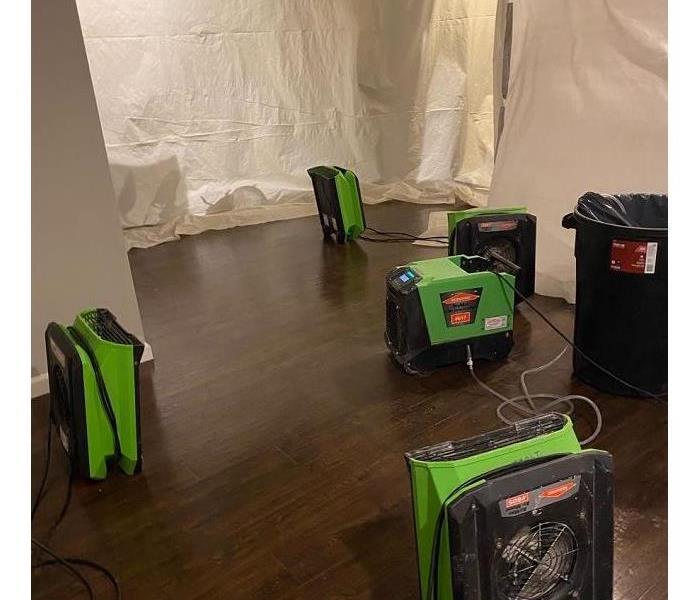 A pipe in the upstairs bathroom broke sending gallons of water through the ceiling into the floor below.
A pipe in the upstairs bathroom broke sending gallons of water through the ceiling into the floor below.
Here to help anywhere in the Hudson Valley with an emergency response 24 hours a day, 7 days a week!
Our property restoration pros are on standby 24 hours a day for any fire and water emergencies. When you are dealing with any kind of water damage or a sewage backup, immediate action is crucial. A delay of just a few hours can greatly increase the severity of the water damage and increase the chances of secondary issues like mold growth and structural issues.
No matter the time of day, we have a live staff answering the phone, ready to help no matter what.
We understand that when you call us, you might feel confused, stressed, and overwhelmed. You need an expert to guide you through this crisis. Our staff has the specific water damage training and experience to guide you through every step of the way. At SERVPRO of Western Dutchess County, we specialize in water damage restoration—in fact, it's been the cornerstone of our business since 1992.
What You Can Expect
When you call, we will ask several questions regarding your water damage emergency. These questions will help us determine what equipment and resources to bring, including how many certified SERVPRO Professionals may be needed.
Some of the questions we will ask:
- Your name and contact information
- Your insurance information (if applicable)
- The street address of the water-damaged home or business
- When did the flooding or water damage occur?
- What caused the water damage and has the cause been repaired?
- Is there electricity and heat available (on-site)?
We’ll start getting to work right away to get your home or business back to preloss condition effectively and efficiently. We have a full staff of technicians ready to help at a moment’s notice, no matter the time or holiday!
About SERVPRO of Western Dutchess County
SERVPRO of Western Dutchess County specializes in the cleanup and restoration of residential and commercial property after a fire, smoke, water or sewage damage event. Our staff is highly trained in property damage restoration. From initial and ongoing training at SERVPRO’s corporate training facility to regular IICRC-industry certification, rest assured our staff is equipped with the knowledge and experience to restore your property.
Trust the pros in damage restoration, we’ll help make it "Like it never even happened."
Different Types of Flooding and the Causes | SERVPRO® of Western Dutchess County
5/5/2022 (Permalink)
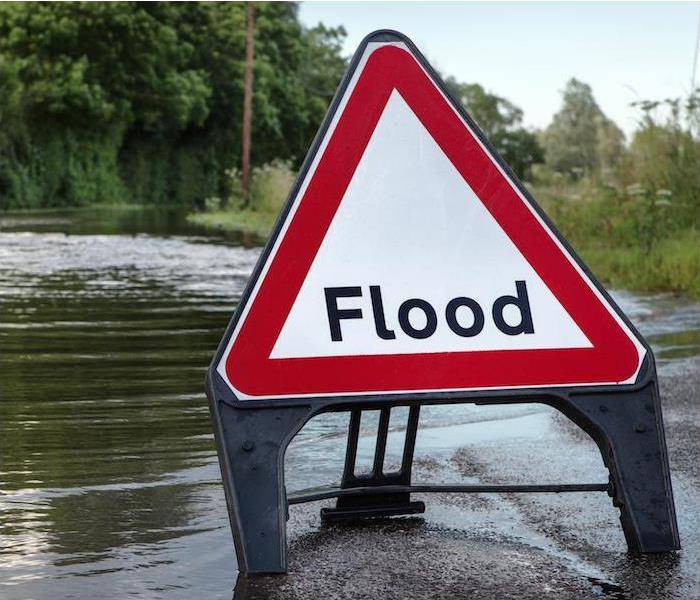 There are many types of floods that can occur in Dutchess County, learn which ones could cause damage to you home!
There are many types of floods that can occur in Dutchess County, learn which ones could cause damage to you home!
The most common natural disaster in the United States is not tornadoes or hurricanes, but rather, it’s flooding. Flooding can negatively affect nearly any location, from individual homes along Wappingers Creek to communities in Beacon and cities in Dutchess County.
All 50 states and every U.S. territory have been affected by floods at one point or another. The only difference is the types of flooding and the causality among all of them. There are three types of flooding that occur, and they happen because of four reasons.
3 Types of Natural FloodingFlash floods are the most common and happen when rains fall so heavily and fast that it overwhelms the ground and its ability to soak in the moisture. The excess water then must run off somewhere and can take garbage cans, yard décor and more with it. We see these a lot when there's a small river of leaves and debris running down the sides of our roads into storm drains.
River floods happen in areas with larger rivers. When a riverbank becomes too full, the water will spill over the sides, causing destruction.
Coastal floods happen in those areas of the world that lie next to large bodies of water. So if a storm surges or a hurricane comes through, it will cause the ocean water levels to rise and cause flooding.
The 4 Most Common Causes of Natural FloodingHeavy rainfall. Sometimes storms produce a lot of rainfall or seem to take a break over a specific area for an extended period. When storms do this, it causes flash flooding. Urban areas are at a particularly high risk of flooding, because of the amount of asphalt versus the amount of soil.
Oceanic activity. Storm surges, hurricanes or a simple rise in the ocean’s tide can cause waves of water to overtake coastal communities.
Dams and levees failing. The most notable example of dams and levees failing is 2005’s Hurricane Katrina. Dams and levees fail when there’s too much pressure, causing cracks in the structure or overtaking the dam’s ability to contain water.
Snowmelts and ice dams. While this isn’t a big factor in our area, there are places in the country where heavy snow and prolonged freezing temperatures are common. When snow and ice build up, they will melt at some point and cause streams or rivers of water to flow through communities. Ice dams or ice jams are likely going to happen because rivers become blocked by the ice buildup.
We are, however, familiar with ice dams in the winter time in the Hudson Valley. These can occur when there's been accumulating snow on a roof, intermittently melting from the attic heat and then refreezing in clogged gutters causing water to force into your home instead of being carried away from it. These are not a type of flooding but cause significant water damage inside your home or business.
Regardless of the cause of the flooding, SERVPRO has the tools and teams to help your home or business recover from its disastrous effects. Contact us anytime when flooding or water damage makes a mess in your life.
Home Maintenance Tips for Water Damage Prevention in Your Hopewell Junction Home
3/4/2022 (Permalink)
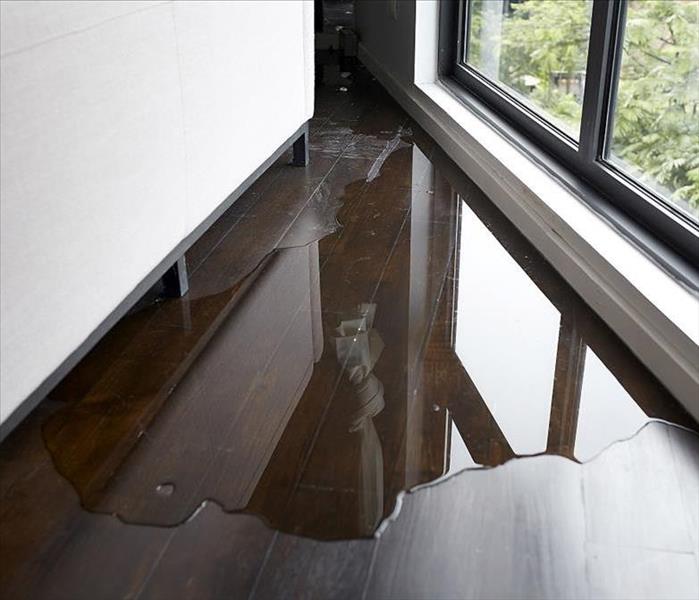 With some regular home maintenance, you can really avoid the headache of water damage in your home!
With some regular home maintenance, you can really avoid the headache of water damage in your home!
Water damage is one of the most stressful situations a homeowner can be faced with. There are many things that can cause water damage, it can be costly if it is discovered late and most
insurances only extend coverage to it in certain scenarios.
The good news is that through regular home maintenance, water damage from many things can be prevented. By taking care of common locations of water damage origins—such as your
landscape, gutters and appliances—you can stop the problem before it begins and not be faced
with an unpleasant surprise later on.
Water Damage Prevention Through Regular Maintenance
-Check Your Landscaping
If your home is situated toward the bottom of a hill or if you have experienced soil settling around
your foundation, pooling water can build up against your home, creating pressure and seeping
in through any cracks. This can lead to water damage to your construction, foundation and lower level as well as seepage and standing
water in the basement or underneath the house. By making landscaping updates to divert water
away from your home , you can stop this from becoming an issue before heavy spring rains
begin.
-Clean Your Gutters
If gutters are clogged with leaves and debris for a long period of time, they can cause serious
water damage issues to your home. Overfilled gutters can lead to a leaky roof and
water-damaged siding, as the water will begin to seep into your shingles and house frame if it is
not able to drain away. Cleaning your home’s gutters at least twice a year is recommended in
order to prevent water damage as well as mold growth. Additionally, clogged gutters can lead to a nasty ice dam situation in the cold months where the water gets stuck and ends up traveling behind the fascia and into your house.
Inspect Appliance Water Lines
Appliances such as refrigerators, dishwashers, hot water heaters and washing machines pump
a lot of water into and out of the house, and while the appliance itself might have a longer
lifespan, the water lines can often wear down over time. This can lead to water damage that
goes undetected for a long time, as it is not common to check under or behind most of these
household objects. Even a slow leak can cause serious water damage issues , so be sure to
inspect these appliances every six months for hidden leaks.
If you’ve experienced water damage to your Dutchess County home, you can always
give us a call! We’re the leaders in water restoration, and you can call us 24/7 for an emergency response.
You Have Water Damage in Your Beacon Home. What Now?
3/1/2022 (Permalink)
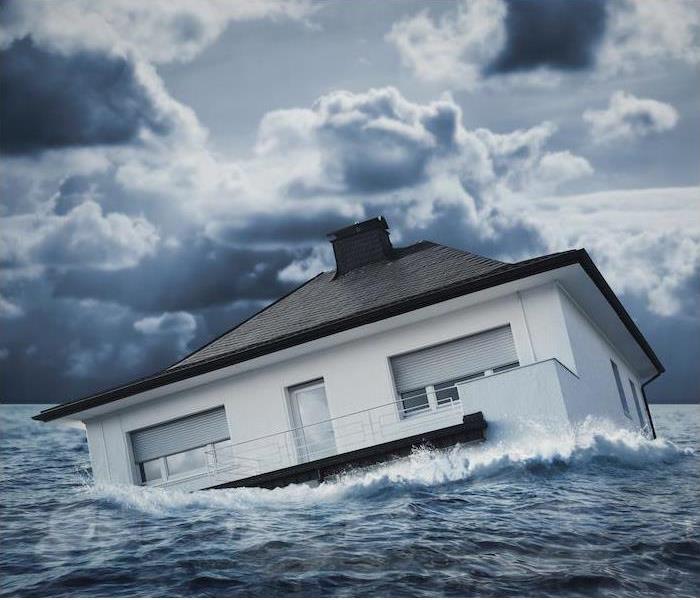 Trust the local PROS with SERVPRO of Western Dutchess County to handle all aspects of water damage in your home!
Trust the local PROS with SERVPRO of Western Dutchess County to handle all aspects of water damage in your home!
On a daily basis, about 14,000 Americans encounter water damage in the home. It’s a common occurrence, but that doesn’t make it any easier on those who experience it!
By contacting your local SERVPRO team, we will get you through the tough times. Here’s what you can expect when you have our team handing your water damage cleanup:
Emergency Contact. We understand that when an emergency happens, you need help instantly and don’t have time to spare. When you call us we spring into action. We’ll ask targeted, specific questions to determine the nature of your disaster and set up an appointment to visit your home for an in-person assessment.
Inspection and Water Damage Assessment. When we arrive at your home, the first thing we’ll do is ensure that the water has been turned off at the main source. Obviously, stopping the water leak or other source of water damage is the most important step. Then we will walk around your home, assessing the damage and noting any potential hazards. From there, we’ll develop a plan for next steps.
Water Removal. The first thing we need to do is remove the standing water in your home. To do this, we have powerful pumps and extraction units that will get rid of hundreds or thousands of gallons of water. This will help reduce the overall drying time for your home and prevent mold growth.
Damaged Material Removal. Anything that water has touched in your home will either need to be replaced or restored. Our goal is to restore as much as possible, but some items may be damaged beyond repair. We’ll swiftly remove those and prepare for replacement.
Cleaning, Sanitizing and Deodorization. Water that seeps into furniture or sheetrock can leave behind nasty odors and hazards, so it’s important to sanitize and deodorize the home. We have the cutting-edge equipment to do just that.
Drying. After standing water is removed, it’s important to remember that there is probably still excess moisture in the home that you should concern yourself with. Excess moisture from any source can quickly contribute to mold growth. We will use powerful technology to restore a normal moisture balance.
Monitoring. As your home dries out, we will remain in constant contact with you and make daily visits to ensure that it’s drying properly. We will adjust equipment if needed, and monitor the entire situation to make sure things are proceeding smoothly and quickly.
Repairs and Construction. At the end, the last and final step is to restore your home. Whether your home requires a minor repair or something large like a rebuild, we will get it done for you. Consider us your one-stop-shop for water damage repair and restoration.
When water damage strikes, make the call to SERVPRO of Western Dutchess County for A-to-Z cleanup and restoration. We’ll make your damaged property look “Like it never even happened.”
The Differences Between Water Damage and Flood Damage | SERVPRO® of Western Dutchess County
3/1/2022 (Permalink)
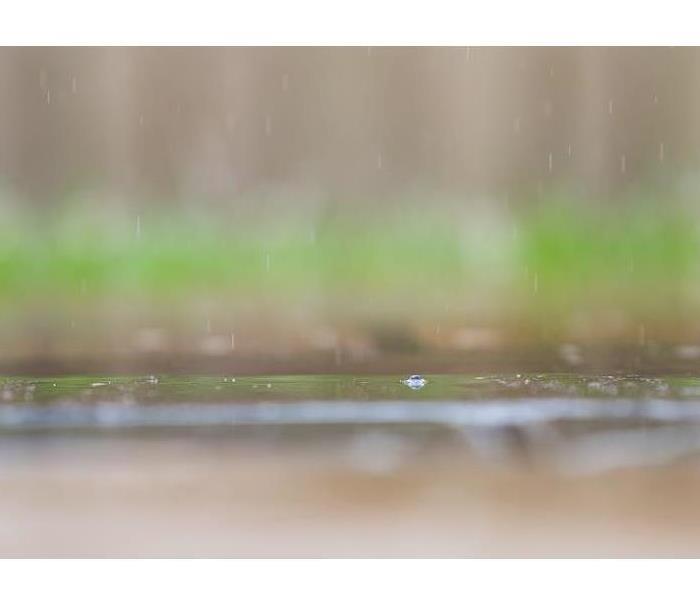 Knowing the differences between water damage and flooding can really help with the restoration of your home or business!
Knowing the differences between water damage and flooding can really help with the restoration of your home or business!
There is no type of water damage that a homeowner in Dutchess County will *want* to deal with, but there are several different types of water damage that homeowners should always be aware of. Water damage will typically come as a complete surprise, whether it is a result of a flash flood, burst pipe or sewage backup.
In these scenarios, it is important to be prepared so you know what the best course of action is
for your situation. While water damage and flood damage are fundamentally different, knowing
how to react to them can help you take action quickly so you can have the damage remedied
much faster.
Causes of Water Damage
In the most general of terms, water damage occurs by water that has yet to make contact with
the ground. Water damage can be caused by plumbing issues, such as leaks, backed-up
sewage or drains or burst pipes within the home, but it can also be caused by weather-related
incidents.
For example, if there are heavy rains, a leak in your roof or around a window frame would be
considered water damage, whereas storm water seeping into a basement would likely be
deemed as flood damage.
Causes of Flood Damage
Floods are defined simply as “an excess of water on land that is normally dry.” Floods can be
caused by an overflow of bodies of water or rapid accumulation of runoff in surface waters, in
addition to mudflow.
Floods can happen in known floodplains, but they can also happen in areas without a history of
flooding due to various factors. 2021 certainly showed us that with the influx of water many of us experienced and have never had flooding before.
How Differently Are Water Damage and Flood Damage Handled?
Flood damage and water damage are similar, but the way they are handled is quite different.
Depending on the incident that caused the flood, floodwater can often be extremely
contaminated and must be dealt with quite carefully to avoid injury or bodily harm.
Additionally, household water damage will often be covered by insurance, whereas flood
damage is only covered if a homeowner has purchased a separate flood insurance policy.
In either case, it is important to promptly get professional water restoration help—mold can quickly begin growing after water damage, and water contamination can make this
issue even more serious.
*If you have water or flood damage in your home, we can help! We are experienced with both types of restoration and are here for your emergencies 24/7. Call SERVPRO of Western Dutchess County as soon as you find a problem!
Know Where to Look for the Source of a Leak in Your Wappingers Falls Home
12/15/2021 (Permalink)
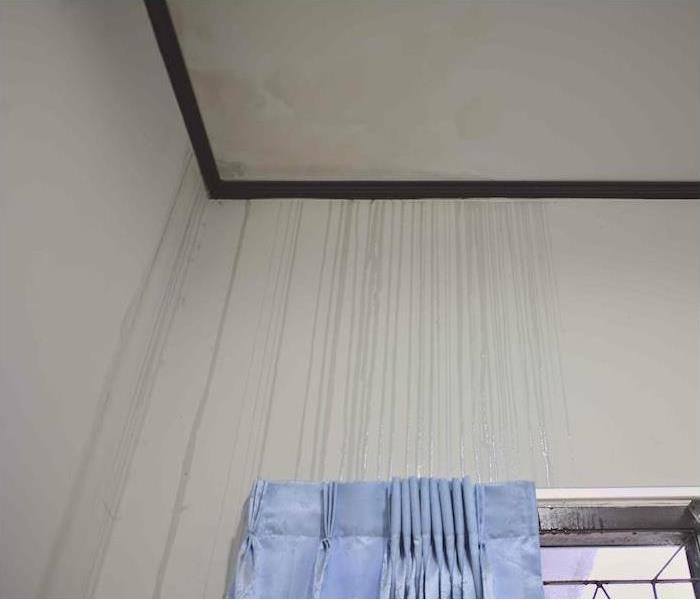 Be thorough checking your Wappingers Falls home for water damage to help avoid a nasty headache!
Be thorough checking your Wappingers Falls home for water damage to help avoid a nasty headache!
Water damage can be a huge inconvenience and distraction that no one wants to deal with. We rarely get advanced notice before something damaging occurs. Water is always looking for a place to go, and it always takes the path of least resistance and that can be through many levels or floors of your Dutchess County home.
Knowledge is a great thing. If you can educate yourself about where water can get into your house, some preventive maintenance could go a long way in avoiding damage and costly repairs to your home. Let’s look at a few of the most common sources of home water damage:
Showers. Showers have a number of places that could leak, including fixtures and drains, cracks in a fiberglass tub, and missing grout on tile. Showers are used daily and should be inspected each time they are cleaned. If possible, check the room below it to see if there are water stains or moisture on the ceiling.
Washing machine drain hose. The washing machine drain hose connects to the household drain system in the form of an upside down J-shaped pipe. This pipe should be at least as high as the washing machine itself to prevent siphoning. The pipe should be secured in the drain with a clamp. During the discharge of water from the washing machine, pressure is created in the drain system. The hose, if not secured, could push out of the drain.
Broken or improperly sloped gutters. Gutters are an important component of the roof drainage system. Gutters should be debris-free and sloped toward the downspout to ensure proper emptying of water from the gutter. Broken gutters should be repaired immediately to prevent leaks into the house or foundation damage.
Pipe vent boots. Pipe vent boots secure the venting component of the plumbing system from water infiltration. These boots are engineered to last at least 15 years and should be inspected annually.
Obstruction of outdoor drains. Drain obstructions blocking the path out of the home are common. Whether tress roots have invaded the drain pipe or grease and food particles have solidified to form a clog, the drain line is where all waste water from your home is removed.
Grease solidification. Excessive food can clog disposals, and hair and oil can clog drains and other pipes. Plunging too much or too hard can cause loose fittings to give way, spilling water under your sink. Grease should cool into a solid and then be scrapped off and put in the trash. Never pour excess grease down the drain.
It’s important to keep up with the state of your appliances, pipes and roof, as they all have an expiration date and require periodic maintenance. If you can catch the signs of wear before a leak occurs, you can save yourself a costly headache.
If a water leak turns into a problem at home, you’ve got the best team in the business on your side. Contact SERVPRO of Western Dutchess County today so we can get started. Here to help, locally since 1992.
Water Damage Numbers Speak Volumes | SERVPRO® of Western Dutchess County
12/10/2021 (Permalink)
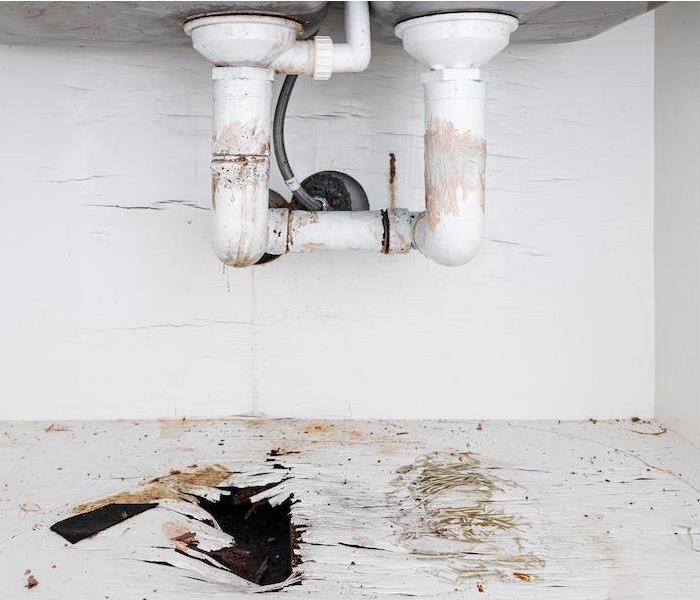 Routine maintenance on your home can really help keep your home out of the water damage statistics!
Routine maintenance on your home can really help keep your home out of the water damage statistics!
As adults, we all have learned that life can be tough, unfair and exhausting. We work hard to provide for our family, keep up with monthly bills and stay on top of home maintenance. However, no matter how hard we try, "adulting" is just what must be done.
When you decide to buy a home in Dutchess County, you know going in that you are taking on a lot of responsibility as well as risk (regardless of where). At some point or another, no matter how much you prepare, your home is likely to be affected by water damage of some kind.
With that being said, you can take some peace of mind in knowing that you are keeping your pipes and appliances well-equipped and maintained. Doing so can lower your risk of becoming part of the water damage statistics:
- This is the percentage of all home insurance claims pertaining to water damage. That’s one out of every 50 homeowners that file a water claim in a given year.
- When water strikes your home, the only appropriate response is to act quickly. You only have approximately 48 hours before mold can set in, which will cause you even larger problems. And honestly, sometimes it doesn’t even take 48 hours.
- If you own a home that has a cool basement that has become a man cave or game room, you might not like this one- Homes with a basement have a 98% chance of experiencing water damage. Ground water penetration, pipes bursting, flooding from storms or run off, hot water heater failures, toilet line breaks…basements are the total victim here.
10,234. This may seem like a large number, and it is, but when you consider that it is the average amount of money paid out for water damage, you might rethink that. If you were to put a value on things in your home that water has affected, this number can seem relatively small. Between the flooring, walls, insulation, appliance replacement and don’t forget about furniture, clothing, electronics and personal effects.
14,000. This number shows how many Americans encounter water damage every single day! To put that in perspective, that means that every six seconds, someone is dealing with a new burst pipe or appliance that gave out.
13,000,000,000. Yes, this is a lot of zeroes! $13 million is the amount of money paid out each year in the United States for water damage.
Now that you see the numbers, you can see that water damage is something that happens every single day. And while these numbers can be somewhat overwhelming, you can sleep easy knowing that most water damage is preventable with proper upkeep and maintenance. Make sure you are doing your part in ensuring that your home is well-maintained and cared for.
Keep up to date on your homeowner’s insurance policy as well. Make sure to make any revisions for flood coverage, sump pump installations, mold remediation coverage, and personal property changes.
If water damage catches you off-guard and leaves you all wet, you’ve got help on your side. Contact SERVPRO of Western Dutchess County to see how we can quickly and fully restore water damage to your home or business. We’re here to help 24/7!
Don't Overlook Bathroom Water Damage in Your Poughkeepsie Home!
5/11/2021 (Permalink)
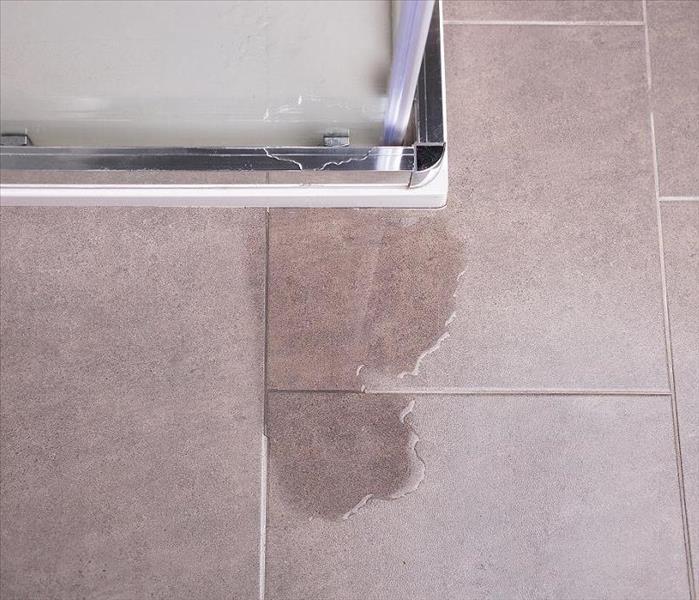 Bathroom water damages can be a huge and expensive hassle if they're overlooked, keep an eye on water issues!
Bathroom water damages can be a huge and expensive hassle if they're overlooked, keep an eye on water issues!
If you’re like most people, your bathroom is one of the dampest spots in your home. Between the sinks, showers and bathtubs, there’s a lot of plumbing going in and out of your bathroom. And it’s plumbing you use every day.
Along with your kitchen and your basement, your bathroom is one of the most common places that water damage can be found. Like the kitchen, your bathroom can show small signs of water damage that are evident before the issue becomes serious.
Because water damage and plumbing repairs can quickly become costly and extensive, it’s a good idea to periodically check your bathroom for small signs of water damage. When you catch a leak or damage early, you can take the necessary steps to correct the problem before it evolves into a major issue.
Since water damage spreads quickly, the sooner you begin to correct the process, the better off you and your home will be. Here are some things you might notice when you’re dealing with bathroom water damage:
Standing water should always raise a red flag. Whether the water is standing inside your shower or on your floor, it’s something that needs to be evaluated. You may want to check for clogs or get in touch with a plumber.
Damp drywall can be a sign of a leak behind your wall. If you notice your drywall has damp spots, water spots or stains, you may be dealing with a leak near it or behind it. That leak will need to be repaired and the resulting water damage corrected. The longer that leak goes, the worse all around it will be for repairs and remediation to the damaged areas around it.
Signs of mold mean a water issue. If you notice mold spots under your bathroom sink, near your tub or around your ceiling, then you likely have a water issue in your bathroom. Mold spreads easily and fast, so any issue like this should be repaired as quickly as possible.
If your home is damaged due to fire, water, sewage or any other cause, the team at SERVPRO of Western Dutchess County has the experience and equipment to meet your needs and get your home restored to its original state. Call us at any hour for assistance, we’re ready to help your family, 24/7.
Tips You Can Use to Keep Your Home Safer This Spring Season | SERVPRO® of Western Dutchess County
3/8/2021 (Permalink)
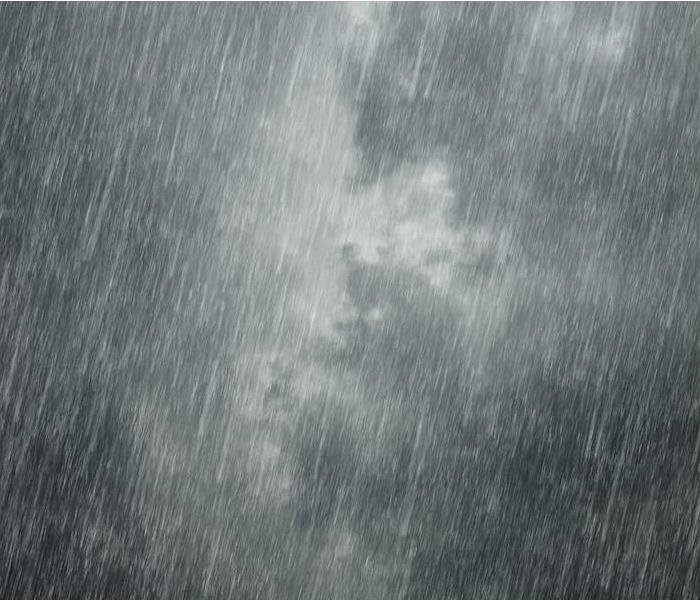 Be sure to keep your home safe from water damage during Spring storms!
Be sure to keep your home safe from water damage during Spring storms!
Who isn’t looking forward to spring after a long winter?
Its March now, temps are rising so it’s not surprising if you are ready for a fresh, new season. Dutchess County residents are ready for warmer weather and the ability to get outside and work on landscaping, DIY projects and other outdoor pursuits.
If you’re a fan of doing DIY projects, then you might want to consider doing work that will not only make your home look more attractive but will also help protect it against the hazards spring thunderstorms can bring.
There’s nothing we can do to stop storms from hitting. After all, we can’t control the weather, can we? But there are things we can do to put our homes in the best position to weather the issues.
How to Protect Your Home from Storms
Here are some items you’ll want to put on your to-do list for the next year:
Keep an eye out for tree limbs that hang over your home. Limbs and branches overhanging your house can come down when the winds get high and heavy. Cut down any stems hanging over your roof or garage.
Clean your home’s gutters. We talk about this step frequently in our home maintenance guidance, and there’s a good reason for that. Clean, clear gutters are an excellent way to keep water around your home flowing the right way, instead of causing water damage.
Look for issues with your roof. You want to be sure your roof is in good shape before a storm starts hitting. Check for things like missing shingles and signs of leaks. Repair them to keep your home safer.
Be sure anything that’s around your home is secure, too. Don’t let unsecured furniture or other similar items become tools for wind damage. Trim back trees that need it and secure everything you can if there’s a storm threat in the area.
If a storm, flood or any other cause damage to your home, you can always count on us for restoration assistance. We are available 24⁄7 in the event of an emergency. Contact us at any time to learn more about our restoration services and how we can help you.
Snow Melt & Heavy Rains Can Lead to Water Damage in your Beacon Home
2/26/2021 (Permalink)
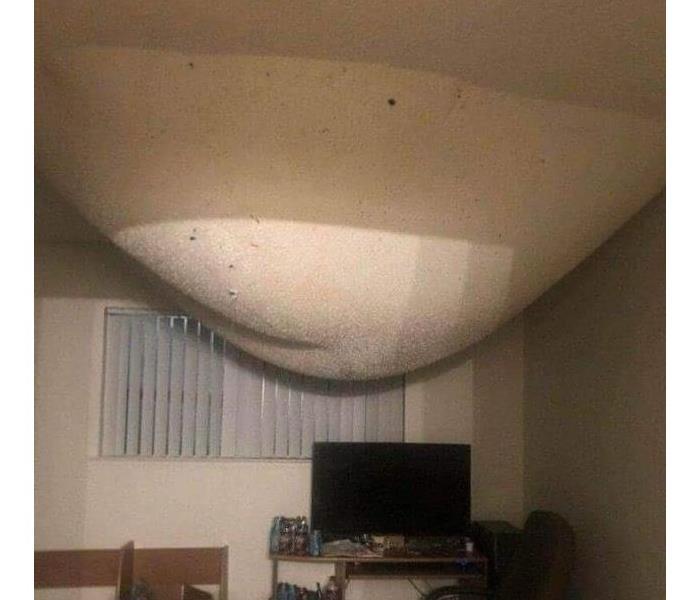 Heavy rain and melting snow can lead to significant interior water damage!
Heavy rain and melting snow can lead to significant interior water damage!
Typically, when you think of water damage, you might picture a toilet, a sink or tub overflowing or maybe a burst pipe spraying water everywhere. However, many times, water damage can happen without you even knowing, such as in the event of heavy rain or snow melting.
When rain falls hard enough and there’s a lot of snow melting (especially after thawing and refreezing over and over), the heaviness will really soak everything in sight and, can unearth problems you weren’t aware of being issues in your home.
Water Can Seep in Through the Smallest Openings
When it rains enough for things to get continually soaked, miniature cracks, splits, holes and openings in your home’s exterior can begin to let water through and start leading to problems. These issues can be on your roof, around windows and doors, and even ground water seeping through foundation walls.
Consider installing weather-stripping around doors and windows. This can be one of the best methods to help prevent water damage from a soaking rain as well as being an inexpensive way of keeping up with your home’s exterior paint to avoid any gaps or peeling that might allow water through.
Take a good look at your windows closely, both interior and exterior for small holes and feel around for any drafts. Be sure to seal them well or have them replaced if needed. Basements, crawl space and attic entrances, garage doors, mud room and porch doors and windows should all be examined for possible ways for water to get in.
Gutter Clogs Can Lead to Water Damage
Clogged gutters are a big cause of water damage. If a gutter is clogged with debris, branches, leaves, dirt and sometimes nesting, that can all cause water to back up and pool in concentrated areas, which can then be absorbed into your home’s roofline and lead to water getting inside walls and pooling on floors. This is especially true during extremely heavy rains, which can inundate even normally functioning systems with an overload of water.
Ice damming in the winter is another cause of damage. With large amounts of snow on the roof, usually stuck at the gutter line (icicles hanging are a good sign of that), excessive warming that might come from your attic can cause the built up ice and snow to push under the soffits and inside the walls. Cleaning out gutters every spring and fall is the best remedy for this plus keeping your attic at colder temperatures helps too.
Improper Drainage Can Cause Foundation Damage
If the drainage around the base of your home is not adequate, serious water damage can happen as a result—especially during exceptionally wet periods. Making changes to your landscaping to help keep water far away from your home’s foundation can prevent water pooling in the basement as well as the potential for mold growth.
Some basements are prone to flooding from ground water, small foundation cracks and being so close to a water table. Sump pumps, dehumidifiers and special water repellent sealant can really help, depending on the cause of the water intrusion.
Heavy Rains Can Unearth Roof Leaks
You may not be aware you have a roof leak, but a good storm can be enough to turn a small, unnoticed leak into one has become a significant problem. Seeing wet spots, paint bubbles or discoloration on your home’s ceiling often only happens after heavy rains have increased a leak’s severity, creating a need for immediate repairs. Have your roof inspected by a professional at least once a year. Be sure to inspect your attic regularly too, sometimes small leaks can go unnoticed in there as well.
If your home has experienced water damage due to heavy rains, ice damming or for any cause at all, you can count on us to be there for you. Call us 24/7 to begin the water restoration process right away. The quicker the damage is remediated, the less the chances for costly structural problems or mold growth. Trust the local water damage restoration pros from SERVPRO of Western Dutchess County. Making it “Like it never even happened,” for 30 years.
Water damage can be one of the costliest damages you can experience at your Hopewell Junction home. Here are some ways to avoid it.
2/22/2021 (Permalink)
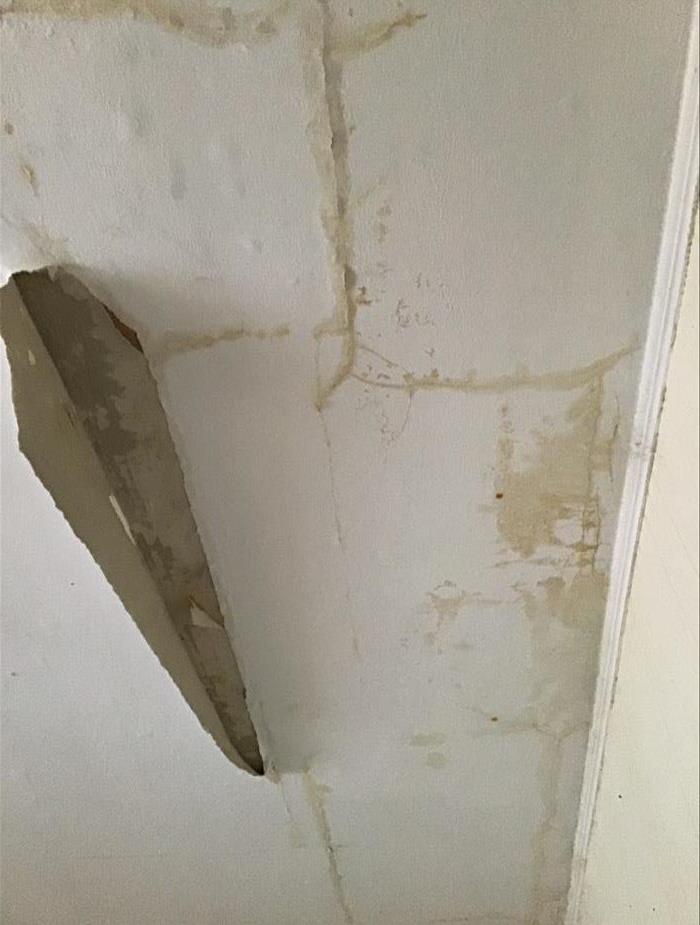 Water damage can occur from various problems in your home, but you can make your house less susceptible to damages by following some easy steps!
Water damage can occur from various problems in your home, but you can make your house less susceptible to damages by following some easy steps!
Water damage is more than must an annoyance to deal with, it can have a long-term impact on your home such as structural issues and potential mold growth. Mold is one of the most common side effects of water damage as it can start to grow and flourish in as little as 48 hours without quick mitigation.
When strategizing ways to protect your home against water damage, it might be easier if you break it down by areas or rooms of impact. These areas could include basements, kitchens, bathrooms, flooring and ceilings.
In the basement, look at resealing vulnerable areas, protecting vulnerable pipes, making sure water drains away from your home, installing a backwater valve and look into installing a sump pump if water collection is common in your basement.
Your kitchen and bathrooms can experience water damage due to plumbing issues like faucet and pipe leaks as well as appliance failures. Be sure you:
- Inspect your appliances regularly, especially the hoses and faucets.
- Check to make sure there are no leaks in the seals or caulking around the shower, tub and toilets. Check under sinks and behind toilets or dripping or mold growth. If you find a leak, have it fixed right away by a professional.
- Know where the main water shut-off valve is in your home and show your family members too. This could be vital info in a larger scale water damage event.
- Don’t leave the house while the clothes washer or dishwasher is running. Being home can help minimize the damage rather than finding a flood in your home when you’ve been out for the day.
If you store contents or items in the basement, avoid cardboard boxes that might sit on the floor. They are known favorites for mold growth. Use waterproof bins to store items and keep items on shelves up off of the floor.
An outside issue can also become an inside issue. Ice Damming can occur in the winter months when snow collects on a sloped roof, ice and icicles can pack against the gutters and under shingles. If your attic is warm and loses heat through the roof, then that can cause the ice to melt and get behind the soffits and inside the walls of your home.
What To Do When You Find Water Damage
If your home does experience a water damage situation, and you act quickly to remedy it, chances are good that your furniture and belongings can be cleaned and dried out.
Get a professional to repair the source of the water problem, call your insurance company to file a claim and then call the certified experts at SERVPRO of Western Dutchess County, we’re here to help 24/7 and will get you back to preloss condition quickly and effectively. We’ve been the local go-to for water damage restoration in Dutchess County since 1992. Put our # in your phone for quick access (845)831-3600. Whether it be 9pm on a Friday or 3am on a Sunday, we’re here to help.
The Way Water Damage Incidents Are Classified and Categorized | SERVPRO® of Western Dutchess County
2/5/2021 (Permalink)
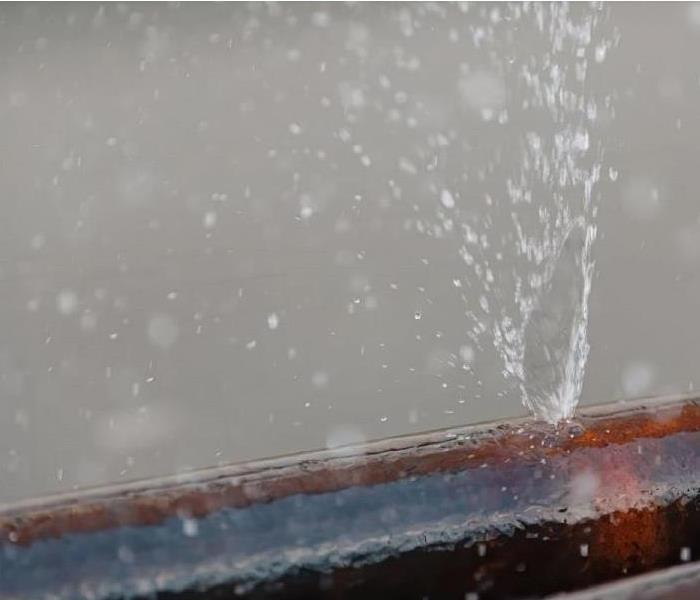 No 2 water damages are the same. A professional restoration company should always be called for mitigation.
No 2 water damages are the same. A professional restoration company should always be called for mitigation.
Water damage is always a serious and frustrating thing to discover in your Beacon home, but did you know that all water damage events are not considered equal? No 2 water damages are alike. There is a myriad of factors that change from house to house or building to building. There are some types of water damage that are not as severe as others, and while any water damage should receive professional attention, the restoration work can range from minor to extensive.
Water damage is divided into classes and categories—the classes have to do with the amount of water and how densely the impacted area is soaked, while the categories have to do with the type of water causing the damage. Below, we will get into more details so you can be better prepared and on the same page when your restoration team arrives.
The Classes of Water Damage
Class One Water Damage: Class one water damage impacts a small area of a room and low-absorbent materials such as wood, tile or concrete.
Class Two Water Damage: Class two water damage impacts an entire room and has soaked into materials such as carpets or cushions but does not rise higher than two feet up the walls.
Class Three Water Damage: Typically from overhead sources such as burst pipes, class three water damage will saturate insulation, walls, carpets and subfloors in an entire room.
Class Four Water Damage: This water damage refers to specialty situations, such as when plaster, hardwood, brick and stone are impacted by water damage in any regard.
The Categories of Water Damage
Category One: Category one water, often referred to as clear water, is water from any sanitary source such as a faucet or toilet tank.
Category Two: Also known as gray water, category two water comes from washing machines, drains or dishwashers, and contains contaminants that can be harmful if touched or ingested.
Category Three: The most dangerous of all types, category three or black water is sourced from sewer backups, floodwaters which have become contaminated or category one or two water that has been allowed to sit for some time.
If you have water damage of any class or category, we can tackle it. You can contact our expert restoration specialists at any time. Our experts are standing by and always here to help.
Count On Us to Help Clean Up After a Pipe Bursts in Your Poughkeepsie Home
1/20/2021 (Permalink)
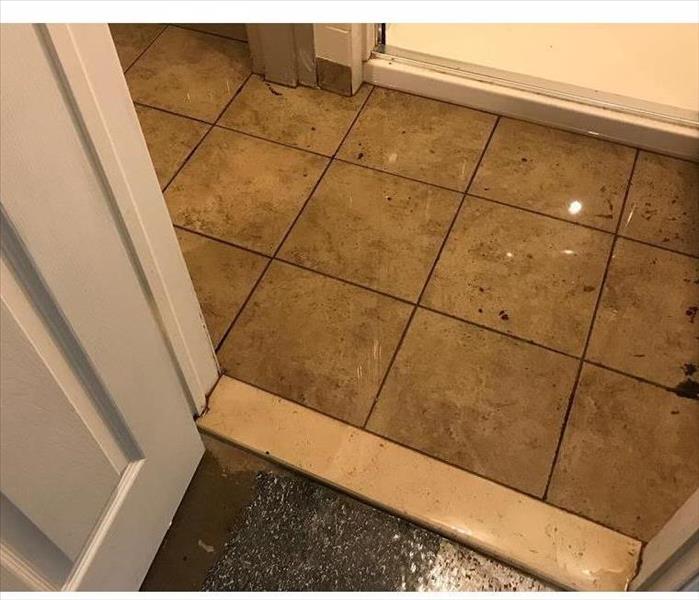 Burst pipes can cause significant damage and should be remedied quickly. Call SERVPRO of Western Dutchess County, we're always here to help!
Burst pipes can cause significant damage and should be remedied quickly. Call SERVPRO of Western Dutchess County, we're always here to help!
Water damage claims are among the most common made by homeowners on their insurance—and that includes people who live right here in the Hudson Valley. These claims are even more common in areas like ours. When winter nights get very cold, pipes are more likely to freeze and burst.
How common are bursting pipes? It’s more common than you probably think. Insurance companies estimate that about 1 in 50 homeowners will file a water damage claim this year—that can be for items ranging from burst and frozen pipes to issues with appliances and furnaces.
What To Do If It Happens to You
No one likes to think about waking up to a burst pipe flooding the kitchen or bathroom, but it is a reality for many Americans. If it happens to you, we want to help you get your house back to its original condition.
There are also a few things you can do at home to help minimize the damage:
Turn off the water. This step seems simple, but it makes a big difference. A burst pipe is capable of pumping a lot of water with a lot of force behind it. The sooner you can stop the flooding in your home, the less damage you’ll have to deal with as you begin the restoration process.
Call a reliable plumber. You’ll want to get a plumber to your home as soon as possible. They can correct the problem and get things working correctly again. A plumber will be able to locate your burst pipe and make repairs. Having the cause or the source of the water fixed quickly will allow for a restoration company to begin the extraction, drying out, and clean up process.
Begin the restoration process. Starting early on water damage is the best way to ensure your restoration process runs smoothly and decrease the chances of secondary damages that can be quite costly (and sometimes not covered by your insurance). Give SERVPRO of Western Dutchess County a call as soon as it happens so we can quickly begin the restoration process. We’re available to help you, 24/7and will work directly with your insurance company to take the burden off of your shoulders.
We Are Here to Help- If your home suffers a loss due to water damage caused by a frozen, burst pipe, appliance malfunction or winter snowstorm, we have local teams ready to help at any time. You can even make it a little easier to get in touch with us by adding our number to your phone so that you can call us immediately. You can reach us 24/7 at (845) 831-3600.
Our team is always ready to meet your needs and help you restore your home. We’ll help get you back to preloss condition effectively and efficiently, "Like it never even happened."
Signs That Point to Water Damage in Your Arlington Home | SERVPRO® of Western Dutchess County
1/8/2021 (Permalink)
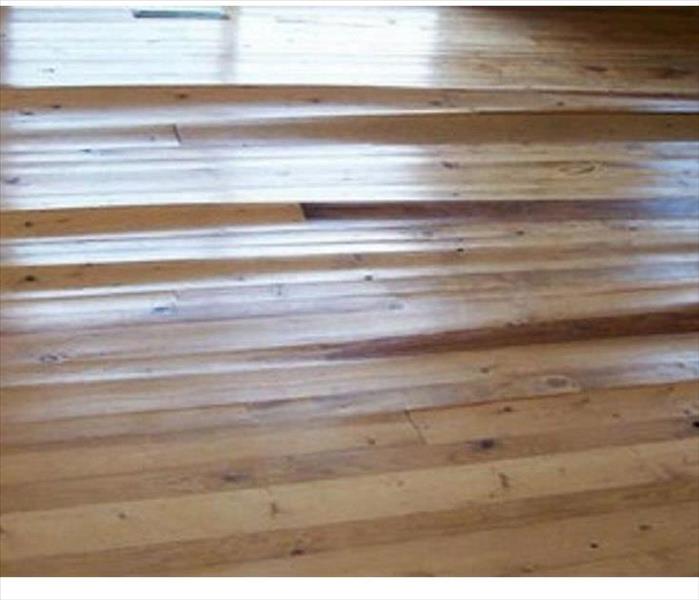 Water can cause a number of different damages to homes, but the sooner you have it remedied, the less the severity can be!
Water can cause a number of different damages to homes, but the sooner you have it remedied, the less the severity can be!
Did you know the number of water damage claims is growing every year? And that’s at the same time that fire damage claims have been dropping.
Water damage claims are always among the most common ones homeowners file on their insurance. About one in 50 American homeowners did it in 2020. Would you know what to do if your home were affected?
When to Reach Out for Professional Help
If you own a home in Arlington, Poughkeepsie or anywhere in Dutchess County, you may be unsure about when you can handle a leak yourself and when you should call for professional services.
Leaks caught early can often be cleaned up with towels and a few minutes of your time. But you may need professional help to set your home back to its original state and prevent further damage to your property if you’re dealing with more serious damage.
You might notice these things when you’re dealing with water damage that needs professional remediation:
Your floorboards or furniture are damaged. Wet wood will start to warp fast. If that happens in your home, it’s best to start seeking help from professionals.
You notice your windows or walls are warping. Like your floors, your window panes and walls can start to warp if the water damage is severe enough. That means you need remediation help.
You notice signs of mold—especially a musty smell. Does your home have a musty odor? That can be among the first signs of mold damage, meaning if you notice that scent, it’s time to call in a professional to help you deal with remediation issues.
If you have water damage in your home due to a burst pipe or another cause, you can count on us for restoration assistance. We have teams available 24⁄7 in the event of an emergency. Contact us at any time, we're always here to help.
How to Avoid Frozen Pipes in Your Hopewell Junction Home
12/16/2020 (Permalink)
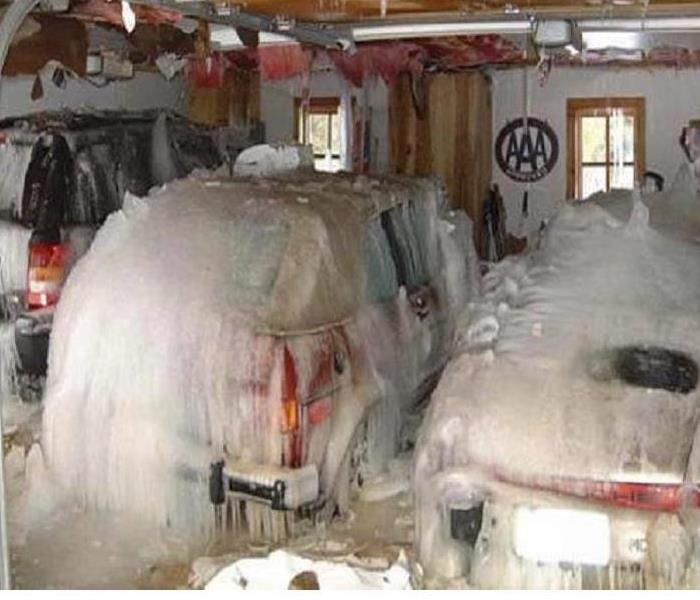 Frozen pipes can cause a tremendous amount of damage. Avoid this problem with our useful tips and tricks!
Frozen pipes can cause a tremendous amount of damage. Avoid this problem with our useful tips and tricks!
The famous Hudson Valley winter temperatures can cause even interior pipes to freeze. While we grin and bear it every year, unprotected or uninsulated pipes just can’t. Burst pipes are one of the most common causes of property damage during frigid weather and can cause thousands in water damage.
Unheated interior spaces like some basements, attics, and garages are the first to cause problems. Vacant homes, 2nd homes and abandoned properties suffer through this issue the most, but even occupied, heated homes with pipes running through cabinets or exterior walls can freeze. There are a few tricks you can do to keep your house dry and your water running.
“Pipe insulation can cost as little as 50 cents per linear foot at your local hardware store,” says Susan Millerick, IBHS spokeswoman.“ So, for not much more than the cost of the aspirin you’d need, you can avoid the headaches of cleanup, loss of precious keepsakes, and the cost of your insurance deductible.” Use the pipe insulation liberally to protect any vulnerable pipes. Certainly avoid any heat sources or flames but otherwise it’s ok to be generous with pipe insulation.
Our tips and tricks to beat the frozen pipe issue:
Once temperatures start dropping outside, you should take precautions inside to keep your pipes warm and water running. Temperatures below 20F are the warning spot so keep the area above at least at 55 degrees that to thwart potential issues.
Keep the thermostat set to the same temperature during day and night. The heart of winter is not the best time to lower the heat to adjust for expenses as a water damage repair can be thousands of dollars to repair and cause plenty of secondary issues like structural problems and possible mold growth.
Open kitchen and bathroom cabinet doors to let warmer air to circulate around the plumbing. (If you have small children, be sure to remove any harmful cleaners and household chemicals.)
Let the cold-water drip from a faucet served by exposed pipes (think basement utility sinks or laundry sinks). Running water through the pipe, even at a trickle, can help prevent pipes from freezing. Similar to a mountain stream that doesn’t freeze over completely as the water is always moving.
Keep garage doors closed, especially if there are water supply lines in the garage. Consider some insulation around the windows and doors to help. Small tricks like these can have a positive affect on the whole house.
If you plan to be away during cold weather, leave the heat on in your home, set to a temperature no lower than 55° F. The last thing you want is to come home to an igloo. Consider a professional to winterize the home or a property management company to keep an eye on things and take care of any issues that arise.
For the long term, add insulation to attics, basements, and crawl spaces. Insulation will maintain higher temperatures in those areas. And to prevent drafts, seal cracks and openings around windows, doors, and at sill plates, where the house rests on its foundation.
Sometimes, things just happen no matter how much you might prepare for it. SERVPRO of Western Dutchess County is here 24/7 for when water damage happens. Call us at 845-831-3600 and we'll make it "Like it never even happened."
What Do I Do If a Pipe Bursts in My Wappingers Falls Home?
12/11/2020 (Permalink)
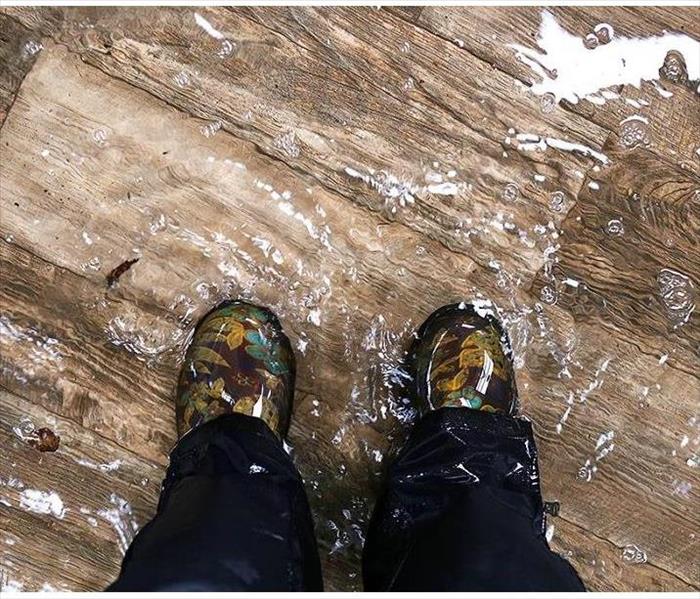 Being prepared for the unexpected pipe break in your home can help you recover quicker, make SERVPRO of Western Dutchess County part of your plan!
Being prepared for the unexpected pipe break in your home can help you recover quicker, make SERVPRO of Western Dutchess County part of your plan!
No one ever wants to experience water damage in their house, but one of the most significant types of water damage—a burst pipe—is extra difficult to handle. When a pipe bursts, it is able to pump large volumes of water into a room or multiple rooms in a short amount of time, leading to serious damage that comes about fast.
Many people dont think about planning for water damage as the situation seems hypothetical, but having a plan in place is one of the best things you can do. Out of every 50 homes, one will have water damage in a year, but those who are prepared tend to have a much better time recovering.
Know What to Do If You Discover a Burst Pipe
Shut off your water main. If a burst pipe is left unattended, it will continue to pour water into an area indefinitely. Knowing where your home’s water main is located and being able to turn it off can significantly curb the overall damage that is caused.
Shut off your electricity. When you can safely get off to your breaker box, cutting that off is the next thing you should do to prevent water and electricity from coming into contact and causing further and dangerous issues.
Contact your restoration company. When there is water damage, acting quickly is key—which is why we recommend having a restoration company chosen before you ever need them. This way, you can place the call immediately after discovering damage to start the process.
Take photos of the damages. Being able to keep thorough records is a great way to keep things organized, both on your behalf and on the behalf of your insurance company. Taking photos, videos and keeping a list can keep you from forgetting about anything amidst the chaos.
Contact your insurance company. Every insurance policy extends different coverages for different situations, so getting in contact with your provider shortly after water damage is key for understanding exactly if and how you are eligible to file a claim.
Open windows and doors if possible. Reducing drying time is key for reducing the overall damage, so if you can safely do so, opening up windows and doors in addition to wiping up water is a great way to take some moisture out of the equation.
If you have water damage in your home due to a burst pipe or any another cause, you can count on SERVPRO of Western Dutchess County for immediate restoration assistance. We're here to help 24/7 and will make it "Like it never even happened."
How To Protect Your Dutchess County Home From Severe Weather
10/29/2020 (Permalink)
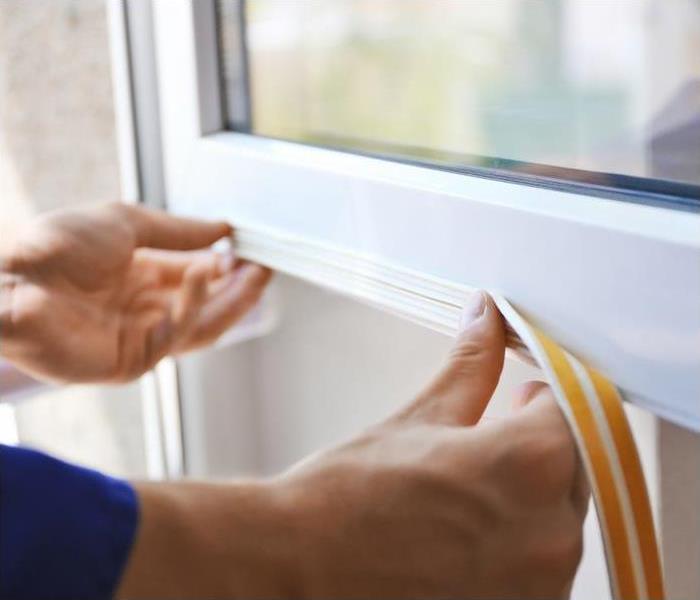 Some easy weather proofing to your home could help avoid water damage from severe storms.
Some easy weather proofing to your home could help avoid water damage from severe storms.
When severe weather is on the way, many homeowners become extremely concerned with the damage that can occur to their homes. If this applies to you, you can gain valuable peace of mind from implementing weatherproofing measures around your house.
Around half of insurance claims are due to weather, but with a bit of preparation, you can help reduce the likelihood of this occurring. Weatherproofing your home is not a huge project—in fact, it is really more about implementing a few key things into your regular home maintenance.
Checking your roof and gutters, installing weather stripping and considering a new coat of paint can go a long way toward preparing for a storm.
Measures to Take Around the House to Increase Weatherproofing
- Keep Your Shingles in Shape
If you live in a newer home, you may have never given a thought to the chance of having a roof leak, but there are many reasons a leak can spring up, even on newly constructed homes. Check in often to look for signs of wear and tear—often loose or missing shingles are a strong first clue. Water stains or leaks in the attic, even mold growth, are sure ways to tell you've got a problem.
2. Beat the Weather with Weather Stripping
Adding weather stripping is an afternoon project that has many benefits. Weather stripping is installed around the doors and windows of the home to seal them from the outside world. Not only does it help prevent water damage from heavy rains, but it is also recommended by Energy.gov because of how much it can save homeowners on energy bills.
3. Gut Debris from Your Gutters
Clogged gutters can lead to water standing in places where it should not be, which can eventually seep into your home and lead to water damage. Gutter cleanings should be done at least twice per year to remove any debris, in addition to checking on them for cracks, signs of drainage issues or other indicators that they may be in need of repair.
4. Pick the Right Paint
The next time your home is in need of a paint refresh, consider choosing a high-tech selection rather than a basic exterior paint. Many paints are now engineered with weatherproofing right in the coat. Technologies like UV ray resistance and waterproofing can make your home more resilient to weather and less likely to experience damage from wear and tear over time.
If you have any water damage from any kind of storm to your home, we are always here to help. Contact us 24 hours a day for a rapid response.
Why Being Prepared Can Decrease the Severity of Damage During a Storm
10/19/2020 (Permalink)
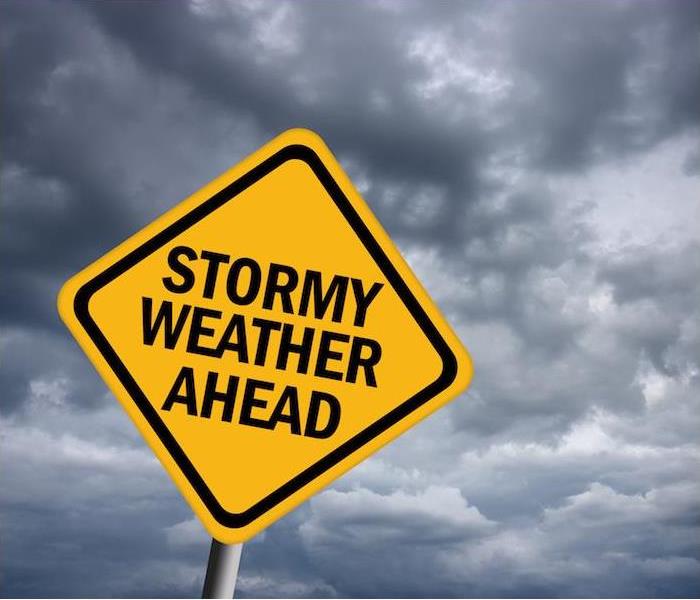 SERVPRO of Western Dutchess County is here to provide you with a rapid response. Contact us right away if you experience any storm damage.
SERVPRO of Western Dutchess County is here to provide you with a rapid response. Contact us right away if you experience any storm damage.
When one thunderstorm moves through an area and leaves without any incident, assuming the next one will be the same is common. However, all it takes is a single storm to cause heavy damages, and every single one has the potential, too.
We always recommend preparing in advance of these storms so that when a severe one does move into the area, you will know you have done all that you can to reduce damages.
Know You Have Done All You Can to Reduce Damages
Prepare your home as much as possible. It can be impossible to predict exactly what types of damages a storm will do, but by trimming back any errant tree branches and securing any loose objects around your yard, you can at least prevent the wind from running things into your house. Another household preparedness tip many people consider is installing a storm generator so you can still use your home’s electronics after a storm. Some owners have installed sump pumps and generators in their basements as a way to help from flooding.
Create a family communications plan. When your family is safe at home and severe weather is imminent, it is easy to get everyone to your designated sheltering area and know for a fact you are all safe. However, if your family is out and about, it can be more difficult. We always recommend coming up with an emergency communications plan so you can all check-in and be sure everyone is safe. Make sure your pets are part of this plan as well.
Make sure your emergency kit is stocked. Packing your family an emergency supply kit is highly recommended, as it will contain everything you need to stay safe and comfortable both during and after a storm. Make sure you have enough food, water, medication and other supplies (including pet food) to last everyone at least 72 hours to be safe.
Consider getting a weather radio. While we all rely on our phones for any pertinent alerts, cell networks can often be unreliable during severe weather. We always recommend having a secondary way to get alerts other than your phone or something electronic, such as a weather radio. This way, you never have to worry about missing essential emergency updates when a storm is nearby.
If your home is damaged by a storm, you can depend on the local property restoration experts at SERVPRO of Western Dutchess County to take care of any damages. Contact us at any hour to report damage and receive a rapid response.
Water Damage in Your Wappingers Home or Business Might Pose A Health Threat, Learn the Categories of Water
10/14/2020 (Permalink)
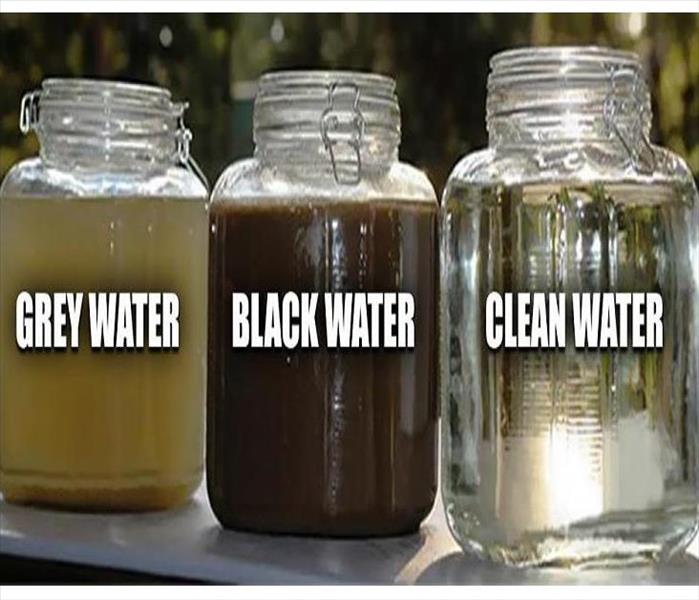 Learn the 3 types of water when you've sustained water damage in your home or business.
Learn the 3 types of water when you've sustained water damage in your home or business.
Toilet overflows, interior pipe bursts, ice damming and storm flooding are each classified as different types of water. Some can contain bacteria, chemicals, debris or waste. Don’t assume it's harmless water when you suffer a water damage in your home! There are 3 distinct categories: clean water, gray water and black water.
The 1st step is always the same, clean it up and dry it out, as soon as possible is best to avoid the threat of mold growth. It’s highly recommended to hire a professional restoration company to make sure all areas are dry, as some of these damages affect sub-floors, drywall, insulation and other interior parts of the home’s structure that have to be dealt with carefully and with the right equipment. Keep these things in mind as it will vary the type of cleaning and remediation depending on what you’re dealing with:
1: Clean Water
Clean water doesn’t pose an immediate threat to your health. Clean water is free of bacteria, microbes and other contaminants and is usually the result of snow or rainwater, broken water lines, toilet holding tanks, and malfunctioning appliances. While this water can contain naturally occurring minerals, it’s not drinkable but isn’t a super hazard.
Important Fact- it only takes 48 hours and contact with the surfaces of a home for clean water to become a category 2, Gray Water.
2: Gray Water
Gray water means the water damage cleanup and restoration needs to become more serious. This water may create a health risk since it will contain degrees of chemical, viral or biological contamination. It has the potential to cause illness if contacted or consumed.
Gray water occurs from toilet bowls overflows, sump pump failures, dishwashers, aquariums, washing machines and showers. The 48-hour exposure time applies here as well, since gray water becomes black water if not treated.
3: Black Water
Where there is black water, you now have the most serious of the 3 categories. Black water is considered highly contaminated as it usually contains or has encountered harmful chemicals, fungi and biological matter and can cause illness. The sources are toilet back flows, sewage pipe backups, seawater, rising water from rivers or streams, ground surface water or standing water.
It is best to treat all waters associated with water damage as black water because water picks up contaminants along its path. Consider the example of water running inside the sheet rock walls and insulation of your home. Each area it gets into, particles are picked up and carried along to whatever exit it can find, which is never safely outside.
The three classifications of floodwater are recognized by the Institute of Inspection, Cleaning and Remediation Certification (IICRC), an organization that certifies and sets the standards for the cleaning and restoration industries. Our technicians are certified by IICRC standards and best practices in water restoration and are available to help determine the steps to take to get your home back to normal.
It doesn’t matter what type of water has caused damage to your home or business, SERVPRO of Western Dutchess County is here to help get the situation under control. We’re always here to help! Don’t hesitate to reach out to us if you need emergency cleanup and restoration services, call us at 845-831-3600.
Have You Been Considering Installing a Sump Pump In Your Poughkeepsie Home?
10/12/2020 (Permalink)
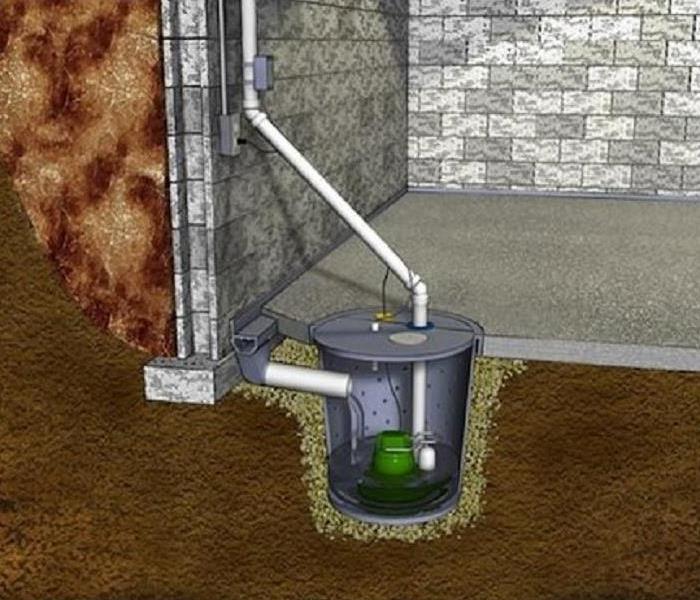 Sump pumps can be a huge help in keeping water damage at bay in your basement or crawl space.
Sump pumps can be a huge help in keeping water damage at bay in your basement or crawl space.
For houses with basements, crawl spaces or in low-lying areas, installing a sump pump is a smart way to significantly reduce the likelihood that you will experience a flood—but it can be difficult to know where to begin.
Understanding the different types of sump pumps is key to picking the best model for your
needs in order to prevent the headache of water damage in your home.
An Overview of the Types of Sump Pumps You Can Install
-Pedestal Sump Pumps-
Pedestal sump pumps are a compact solution, ideal for small spaces where a submersible
pump and piping may not fit well inside the area. Pedestal sump pumps have a high-mounted
motor that sits above the water basin, which makes for easy troubleshooting and maintenance.
These motors are not waterproof, so it is important that they are mounted in such a way that there is no chance of them becoming wet.
-Submersible Sump Pumps-
With a submerged design, a submersible sump pump is basically the inverse of a pedestal
sump pump. Though larger, it is quieter and less invasive, with the added bonus of being
considered safer for households with children as there is less to tinker with by curious hands.
The submersible sump pump detects when the water is at a certain level in the pit and knows to
kick on, which is similar to how a pedestal pump works—but a submersible pump is generally
preferred, as they are known to be longer-lasting and require less maintenance with time.
-Battery Backup Sump Pumps-
A sump pump that is backed up with a battery can either be of a submersible or pedestal style,
but does not rely on your home’s electricity grid to operate. While these styles are typically more
costly upfront, they have the distinct benefit of continuing to do their job even if a storm knocks
out your power. Considering that storms are some of the biggest culprits of flooding to basements and crawl spaces, it might be worth considering these as a long-term investment.
**Check with your insurance carrier, some have specifics in regards to broken sump pumps and having generator or power back ups that you might not be aware of.**
If you’ve experienced water damage in your crawl space or your basement, you can count on us to take care of it quickly. Get in touch to learn more about our water damage restoration process that can work in any space.
Why Treating Water Damage Quickly is Essential in Your Hopewell Junction Home
10/6/2020 (Permalink)
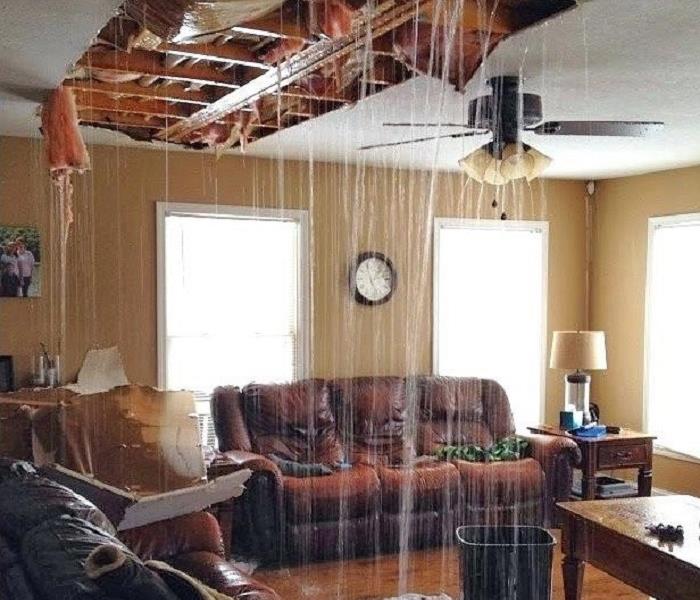 The quicker water damage is remediated, the less hazards you'll face in the near future!
The quicker water damage is remediated, the less hazards you'll face in the near future!
Whether caused by a flood, an appliance leak or something else entirely, water damage is a headache for any homeowner to deal with. While some damages will need to be addressed immediately to make your home livable, if water damage occurs in a more remote part of the house, it may be tempting to wait to have it looked at until a more convenient time. However, this is the worst thing you can do.
Waiting to have your water damage treated can increase the damages, which will, in turn, increase the timeline and the cost of water restoration. Here are just a few things that can happen if water damage is not handled quickly:
Mold Can Begin to Grow Within a Day
While water damage is bad enough to deal with on its own, if mold begins growing, there are many new considerations that can be involved in the restoration. Mold can begin to grow in as little as 48 hours after water damage if conditions are right, leading to a more involved (and more costly) restoration process and possible health effects. Because mold spores waste no time in establishing themselves after water damage, making the restoration call quickly is the best way to prevent it.
Your Home’s Structure Can Become Damaged
Though we generally think of water damage as damage to objects within the home, the very structure of the building can also become damaged if the water has been allowed to sit untreated. Moisture seeps into floors and walls, causing swelling and deterioration among the structural aspects of the home. While this is common in situations of flood damage or burst pipes, it can also occur from much smaller leaks if they are not treated in a timely manner. A plumber or HVAC professional will need to make sure the source of the water is stopped or repaired for the remediation process to begin.
Appliances Can Pose a Hazard
As household appliances like refrigerators, ovens and washing machines sit in water damage-impacted areas, they can become hazardous and even pose a fire risk. Because it is difficult to determine the extent of water damage on your own, calling in a professional to assess the area and determine if your appliances are safe for use is the best course of action to take.
If you have experienced any kind of water damage in your home, don’t put off giving us a call. We are here 24/7 to begin the restoration process right away and make it “Like it never even happened.”
Breaking Down the Depths of Water Damage- Your Wappingers Home and What Water Damage Can Do
10/5/2020 (Permalink)
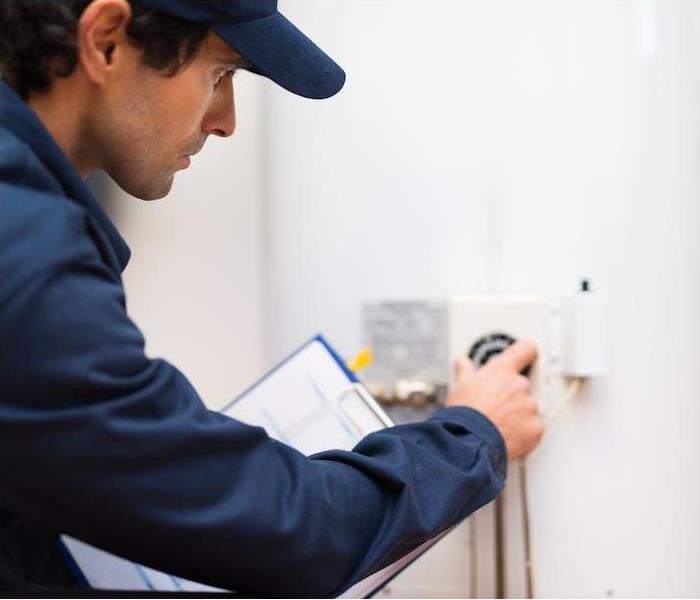 Check your homeowner's insurance policy to make sure you're covered in the event of water damage!
Check your homeowner's insurance policy to make sure you're covered in the event of water damage!
Water—it’s a necessity for life but can also turn into an extremely damaging force in certain situations.
With there being so many types of issues that result in water damage, do you know how to identify and prevent some of them?
Typical Causes of Water Damage
In a six-year period between 2009 and 2015, The Travelers Insurance Companies Inc. reports that the five leading causes of homeowners insurance claims were:
- Exterior wind damage
- Non-weather-related water damage
- Hail
- Weather-related water damage
- Theft
Water damage is so common that it appears on this list twice, in two different categories. To make it simple, remember that it can be classified as non-weather-related and weather-related.
Non-weather-related issues can come from things like plumbing and appliances, while weather-related damage naturally consists of issues caused by rain and snow.
The top five causes for water damage are plumbing issues, leaky washing machines, bursting water pipes, older water heaters and bad weather.
Protecting Your Home From Water
Water damage is a painful expense to be sure, one that could be a thousand times worse if not covered by your homeowners insurance plan. Have you taken the time to review your policy lately? Here are some of the damages caused by water that should be covered in a standard homeowners policy:
- Damages caused by from weight of wintery elements
- Discharge and overflow of water, even by accident
- Tearing apart, cracking, burning or bulging of a steam or hot water heating system
- Freezing of plumbing and pipes
Avoiding water-related issues and potential damage situations is possible. Make use of the following preventive fixes and routine maintenance suggestions to help your home remain free and clear of water issues:
- Applying water sensors and automatic shut-off valves
- Getting back flow valves and standpipes put in basement drains
- Using metal mesh connection hoses on the washer and dryer
- Clearing the gutters and downspouts of debris
- Taking time to flush the hot water tank every six months
- Keeping grease out the kitchen sink and drain
- Running the sump pump every few months and cleaning it before the rainy season
Water damage can be a nightmare to deal with, but fortunately, you will always have SERVPRO® of Western Dutchess County on your side 24/7 to help with the cleanup and restoration process.
What to Do If You Find Water Damage In Your Fishkill Home
9/22/2020 (Permalink)
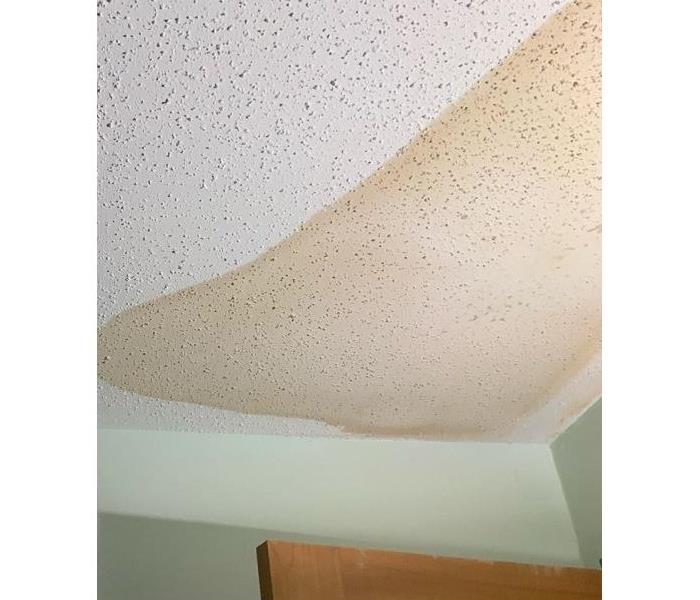 No matter the type of water damage, SERVPRO of Western Dutchess County is always here to help!
No matter the type of water damage, SERVPRO of Western Dutchess County is always here to help!
Finding several inches of water in your basement or a large puddle in your bathroom or kitchen can create a stressful situation very quickly. Knowing immediately what to do is not something you would have instructions for at your fingertips.
**The easiest way to start is to call SERVPRO of Western Dutchess County and our experienced professionals will walk you through every step of the remediation process.
Our teams are available 24 hours a day for all water emergencies, large or small. When you are dealing with water damage, immediate action is crucial. A delay of just a few hours can greatly increase the severity of the water damage and potentially lead to secondary damages like structural integrity and mold growth.
We understand that when you call us, you may be feeling confused, stressed, and not know where to begin. You’ll need an expert to guide you through this crisis. SERVPRO of Western Dutchess County has the specific water damage training and experience to help you through this tough time. We specialize in water damage restoration—in fact, it has been the cornerstone of our business for almost 30 years. We’ll help you with insurance information or locating a plumber or other service professional and work in conjunction with them as well so we can all get you back to preloss condition quickly.
What information we’ll ask for-
When you call, we will ask several questions regarding your water damage emergency. This will help us determine what equipment and resources to bring, including how many trained SERVPRO Professionals may be needed.
Our SERVPRO Representative will ask several questions:
- Your name and contact information
- Your insurance information (if applicable and not mandatory)
- The street address of the water-damaged home or business
- When did the flooding or water damage occur?
- What caused the water damage (if known)?
- Is there electricity available and heat if needed (on-site)?
About SERVPRO of Western Dutchess County
SERVPRO of Western Dutchess County specializes in the cleanup and restoration of residential and commercial property after a fire, smoke, water or sewage damage event. Our staff is highly and continuously trained in property damage restoration and accredited with IICRC-industry certification. You can feel rest assured our staff is equipped with the knowledge to restore your property, no matter the type of damage.
Call us 24/7 at (845)831-3600, we’re always here to help!
How to Identify the Root of a Mysterious Ceiling Leak | SERVPRO® of Western Dutchess County
5/11/2020 (Permalink)
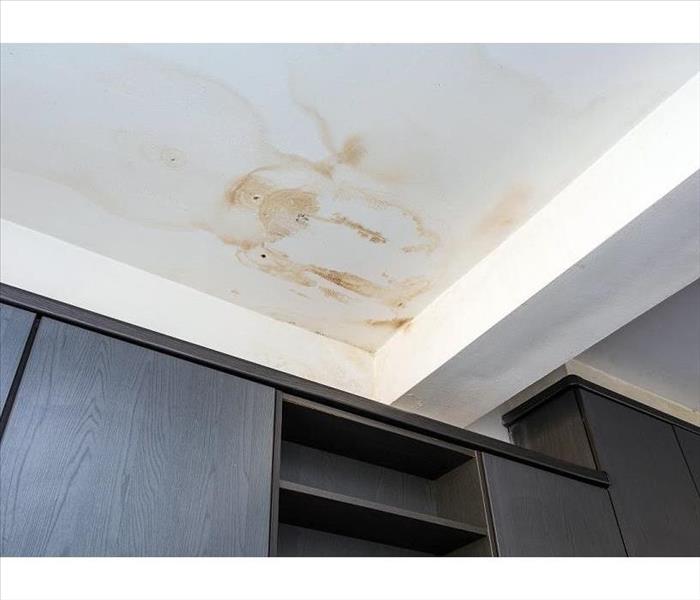 If you're starting to notice stains and markings on your ceilings, call us asap and our experts will get that water damage remedied quickly!
If you're starting to notice stains and markings on your ceilings, call us asap and our experts will get that water damage remedied quickly!
If you have noticed wet spots, discoloration, sagging or buckling on your ceiling or at the top of your walls in your Dutchess County home or business, you may be wondering how to determine exactly where this water is coming from.
Unlike a burst pipe or clear appliance leak, ceiling leaks can be more difficult to diagnose and treat for homeowners as there are many elements that are obscured by the home’s finishes. To help you diagnose the problem, we have included some handy indicators regarding the two common types of ceiling leaks:
How to Identify a Roofing System Ceiling Leak
If you have a ceiling leak in an area of your home that has an attic directly above it, it may be due to a roofing system issue. In most cases, a roof leak will be due to water being allowed to enter through a hole or other compromised area in the roof above. Roofing system leaks can generally be identified by:
- Leaking that occurs while it is raining or pops up shortly after a storm
- Dripping water that is off-colored or murky looking, as it may have picked up debris as it traveled from the roof
- If the leak is correlated with a buildup of ice along the eaves of your home (referred to as ice dams) it may be due to the ice partially melting and seeping into the roof
- Attic insulation that is wet, soggy or has evidence of mold and mildew, which is a sign that it is absorbing some of the water from the leak
- Musty smells or signs of mold around the area above the leak in the attic
How to Identify a Ceiling Leak That Is Due to Plumbing
If the ceiling leak is located in an area where plumbing pipes or fixtures run above it, there may be evidence that it is a plumbing-related problem instead. This is common in rooms located below bathrooms, kitchens or laundry rooms, which are an indicator that the leak is due to supply pipes or drain pipes located within the ceiling. These can be identified by:
- Dripping water that is clear, if it is from a supply line in the ceiling
- Steady leakage that occurs every time you utilize something that might be routed to the plumbing pipes above, or leakage that occurs slowly but regularly, which could indicate a supply pipe issue
Regardless of what type of ceiling leak you have, it is always recommended that you begin the restoration process as quickly as possible to mitigate any further damages.
If you have water damage to your ceiling, call us right away to begin the water restoration process and reduce the likelihood of further damages.
Why Treating Water Damage Quickly Is Essential In Your Poughkeepsie Home
3/10/2020 (Permalink)
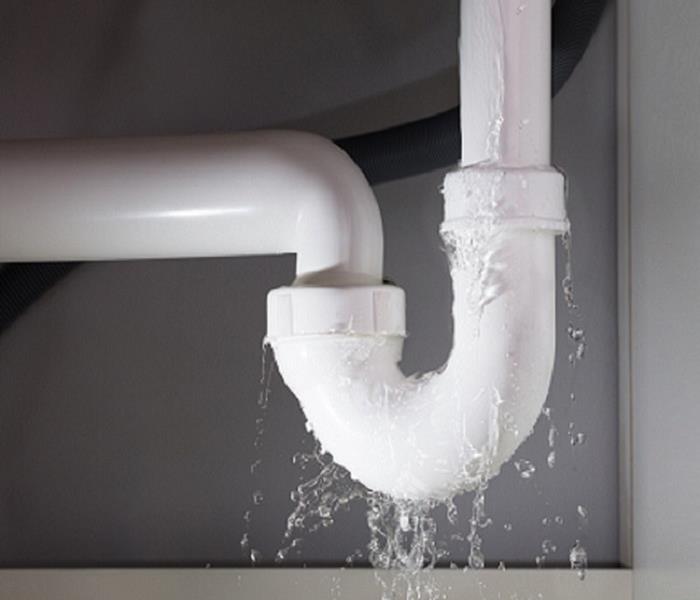 Quick action to fix the leak and remediate a water damage situation is the best way to avoid secondary and more costly damages!
Quick action to fix the leak and remediate a water damage situation is the best way to avoid secondary and more costly damages!
Whether caused by a flood, an appliance leak or something else entirely, water damage is a
headache for any Poughkeepsie homeowner to deal with.
While some damages will need to be addressed
immediately to make your home livable, if water damage occurs in a more remote part of the
house, it may be tempting to wait to have it looked at until a more convenient time. However,
this is the worst thing you can do.
Waiting to have your water damage treated can increase the damages, which will, in turn,
increase the timeline and the cost of water restoration.
Here are just a few things that can
happen if water damage is not handled quickly:
-Mold Can Begin to Grow Within a Day
While water damage is bad enough to deal with on its own, if mold begins growing, there are
many new considerations that will be involved in the restoration. Mold can begin to grow within
24 hours of water damage, if conditions are right, leading not only to extreme health concerns,
but also to a more involved (and more costly) restoration process. Because mold wastes no time
in establishing itself after water damage, making the restoration call quickly is the best way to
prevent it.
-Your Home’s Structure Can Become Damaged
Though we generally think of water damage as damage to objects within the home, the very
structure of the building can also become damaged if the water is allowed to sit untreated.
Moisture can seep into floors and walls, causing swelling and deterioration among the structural
aspects of the home. While this is common in situations of flood damage or burst pipes, it can
also occur from much smaller leaks if they are not treated in a timely manner.
-Appliances Can Pose a Hazard
As household appliances like refrigerators, ovens and washing machines sit in water
damage-impacted areas, they can become hazardous and even pose a fire risk. Because it is
difficult to determine the extent of water damage on your own, calling in a professional to assess
the area and determine if your appliances are safe for use is the best course of action to take.
If you have experienced water damage in your home, don’t put off giving us a call. We are here
24/7 to begin the restoration process right away.
Heavy Rains Can Lead to Water Damage in your Wappingers Home
2/27/2020 (Permalink)
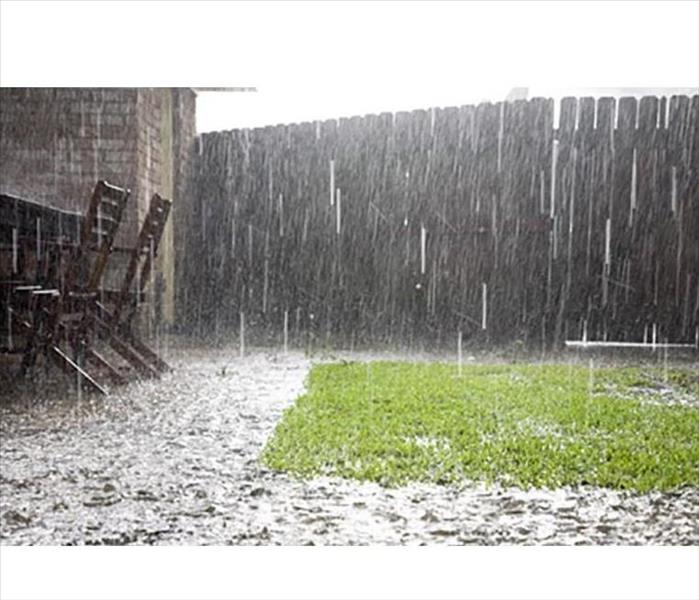 Maintaining some key areas of your home can help keep water damage from heavy rain storms at bay!
Maintaining some key areas of your home can help keep water damage from heavy rain storms at bay!
When most people think of water damage, they probably bring to mind images of toilets or sinks overflowing in their Dutchess County homes or busted pipes spraying water uncontrollably. However, many times, water damage can occur less noticeably than these examples, such as in the event of heavy rain.
When rain falls hard enough heaviness to really soak everything in sight, it can unearth problems you weren’t aware of being issues in your home.
Water Can Seep in Through Miniature Openings
When it rains enough for things to get continually soaked, miniature cracks, splits, holes and openings in your home’s exterior can begin to let water through and start leading to problems.
Consider installing weather-stripping around doors and windows. This small project is one of the best methods to help prevent water damage from a soaking rain as well as keeping up with your home’s exterior paint to avoid any gaps or peeling that might allow water through.
Take a good look at your windows closely for small holes and feel around for any drafts. Be sure to seal them well or have them replaced if needed.
Gutter Clogs Can Lead to Water Damage
Clogged gutters can cause water to back up and pool in concentrated areas, which can then be absorbed into your home’s roof line and lead to damages. This is especially true during extremely heavy rains, which can inundate even normally functioning systems with an overload of water. Cleaning out gutters every spring and fall is the best remedy for this. A clogged gutter in the winter can lead to ice damming which can really cause a headache!
Improper Drainage Can Cause Foundation Damage
If the drainage around the base of your home is not adequate, serious water damage can happen as a result—especially during exceptionally wet periods. Making changes to your landscaping to help keep water far away from your home’s foundation can prevent water pooling in the basement as well as the potential for mold growth.
Heavy Rains Can Unearth Roof Leaks
You may not be aware you have a roof leak, but a good storm can be enough to turn a small, unnoticed leak into one has become a serious problem. Seeing wet spots or discoloration on your home’s ceiling often only happens after heavy rains have increased a leak’s severity, creating a need for immediate repairs. Have your roof inspected by a professional at least once a year. Be sure to inspect your attic regularly too, sometimes small leaks can go unnoticed in there as well.
If your home has experienced water damage due to heavy rains or for any cause at all, you can count on us to be there for you. Call us at any hour to begin the water restoration process right away.
Protecting Your Dutchess County Home From Water Damage
2/26/2020 (Permalink)
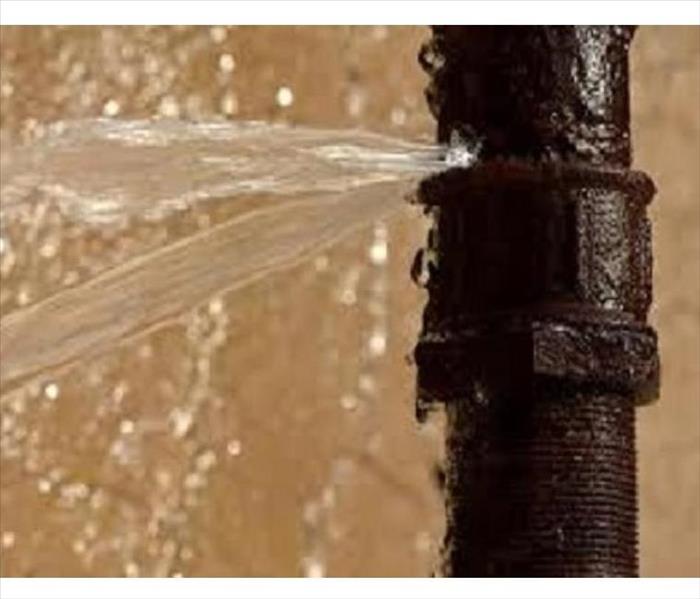 A few preparations can really help protect your home or business from costly and stressful water damage issues!
A few preparations can really help protect your home or business from costly and stressful water damage issues!
This can be an especially common issue for homeowners to deal with, but there are plenty of ways you can help protect your home.
Water damage is more than a hassle to deal with, it can have a long-term impact on your home such as structural issues and mold growth. Mold is one of the most common side effects of water damage because it begins to grow and flourish within 48 hours of exposure to moisture.
When beginning to think of ways to protect your home against water damage, it might be easier if you break it down by areas of impact. These areas could include basements, kitchens, bathrooms, flooring and ceilings.
In the basement, look at resealing vulnerable areas, making sure water drains away from your home and installing a backwater valve and look into a sump pump is water collection tend to happen in your basement.
Your kitchen and bathrooms can experience water damage due to plumbing issues and appliance failures. Be sure you:
- Inspect your appliances regularly, especially the hoses and faucets
- Check to make sure there are no leaks in the seals or caulking around your showers and tubs. If you find a leak, get it fixed right away.
- Know where the main water shut-off valve is in your home and show your family members too.
- Don’t leave the house while the washer or dishwasher is running.
As far as possessions, avoid cardboard boxes that might sit on the floor. Use waterproof bins to store items and keep items stored on shelves up off of the floor.
What To Do After Water Damage
If your home does experience a water damage situation, there is a good chance you can salvage items that can be dried out within 48 hours.
Be sure that you contact your insurance company and a call a plumber or professional RIGHT AWAY to get the cause fixed immediately after you discover the water damage situation.
Then call the experts at SERVPRO of Western Dutchess County, we’re here to help 24/7 and will get you back to preloss condition quickly and effectively. Program our # in your phone for quick access (845)831-3600.
Avoiding frozen pipes in your vacant Wappingers home.
2/10/2020 (Permalink)
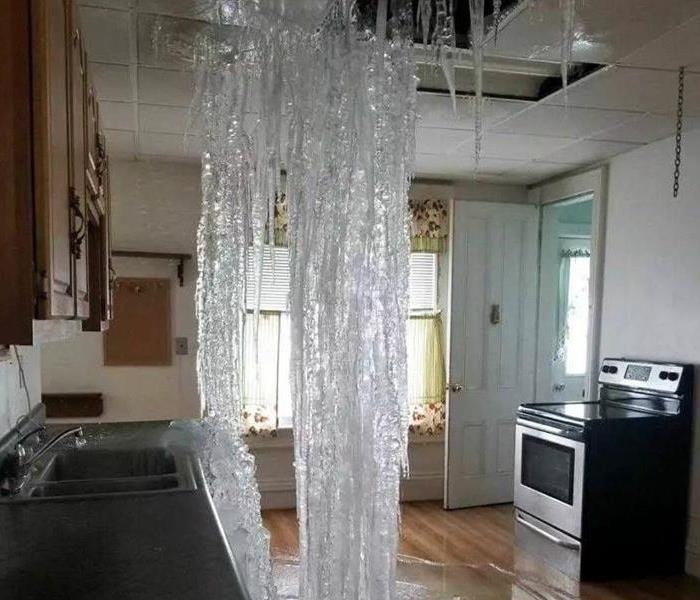 Follow these tips to avoid a major headache in your un-occupied home!
Follow these tips to avoid a major headache in your un-occupied home!
If you own a 2nd home, rental property or have a vacant property for sale, it's important to have it winterized or take precautions against the extreme elements the Hudson Valley throws at us in the winter months.
While there are always unforeseen issues that can happen like appliances failing or storm damage, it's the water that causes the most damage. Water can and will get into everything, continuously finding a way out is the name of the game. As we say in the remediation industry, "water always wins."
Couple of key tips for your vacant property to help stave off water damage:
-Don't turn the heat off in the colder months, rather keep it set to at least 55 degrees and make sure you’ve had an oil delivery or are on a schedule for a rotating one if needed.
-Follow good instructions to protect your pipes like wrapping them with pipe insulation, keeping windows and doors sealed and emptying outside spigots and water sources.
-Have your furnace, heating systems and hot water heater checked regularly. All too often, our professionals see these systems fail in the winter for various reasons and they can cause significant water damage and secondary issues like structural problems and mold growth.
-Have someone check on your house regularly for any issues, making sure to pay attention to mechanicals, pipes and leaks. The last thing you want is to be notified that your house is now an igloo.
- Speak with your insurance agent about tips they have and make sure your policy is where it needs to be. If you have a sump pump in the basement or crawl space, make sure you have the necessary coverage for it should there be a system failure.
-Consider a generator, speak with an expert about what you would need one to do for you in the event you’re not around and the power goes out.
-Keep our name and number in your phone and taped to your fridge should anyone ever need it on your behalf.
Should you ever suffer from water damage, or any kind of loss to your property, call the experts in damage restoration. SERVPRO of Western Dutchess County has been the local leader in the industry for over 25 years, we're here to help 24/7 with certified technicians, extensive experience and the best technology around.
Call us immediately so we can give you piece of mind quickly, no matter the damage and no matter the size, 845-831-3600.
Why You Should Consider Installing a Sump Pump (Even if You Don’t Have a Basement) in your Dutchess County Home
1/21/2020 (Permalink)
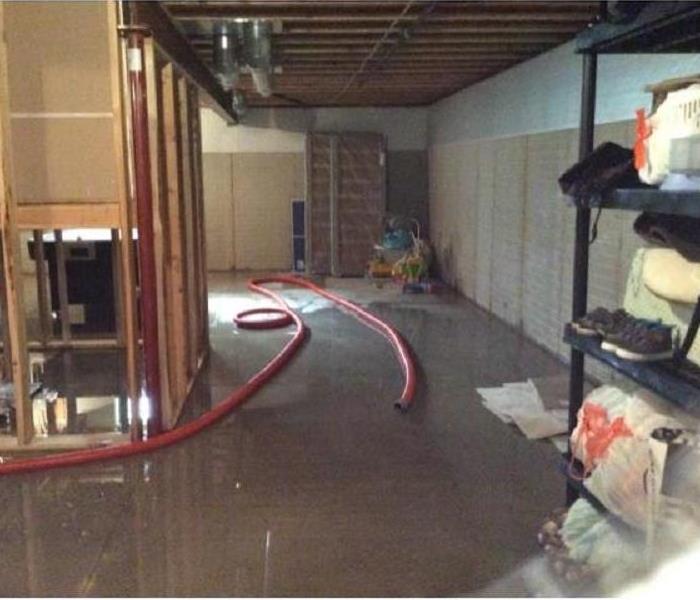 A sump pump can be a very helpful tool to help thwart water damage in your home!
A sump pump can be a very helpful tool to help thwart water damage in your home!
Though sump pumps were once considered a necessity only for finished basements in low-lying regions, with the increase in flooding across the country, the need for them has become more widespread. If installed correctly, sump pumps serve as a valuable tool for water damage prevention and some models can even alert homeowners to potential dangers before they begin.
If you think a sump pump might be a smart investment for your home, read on to discover how they work and why you should consider one.
How Does a Sump Pump Work?
Sump pumps are installed in the lowest-lying area of your basement or crawl space, in a specially crafted housing pit. This means that the pit is the first place water will pool if it begins to accumulate, giving the sump pump the opportunity to pump the water out of the area and away from the home.
Reasons to Consider a Sump Pump
- To Prevent Water Damage to Basements and Crawl Spaces This is certainly the most common—and the most useful—reason that homeowners choose to install sump pumps. Whether you have a fully finished basement you use every day or a small crawl space under your home, any water buildup can cause serious damage to your belongings and your home’s structure.
- To Receive Flood Alerts There have been many developments in the world of home technology, and those advancements have not overlooked sump pumps. Many models are now equipped with early water detection technology, which can alert homeowners via a call or a text if the water level in the basement or crawlspace is in danger of rising. This can save homeowners a tremendous headache, as it allows them to take a proactive approach to water damage instead of having to simply react after it happens.
- To Cut Down on the Chances of Mold Growth Under Your Home Mold is an insidious problem for homeowners, with basements and crawl spaces serving as a mold magnet if they have moisture buildup. Because sump pumps are the first line of defense against moisture in your home, they can also serve as a preventive measure for harmful mold and mildew buildup in spaces where they are installed.
Side Note- make sure you contact your homeowner's insurance company to be aware of coverage changes in regards to installing a sump pump.
If your basement or crawlspace has water damage, you can contact us 24/7 for a quick response from our qualified technicians at (845)831-3600.
Hidden Water Damage From Appliances | SERVPRO® of Western Dutchess County
1/13/2020 (Permalink)
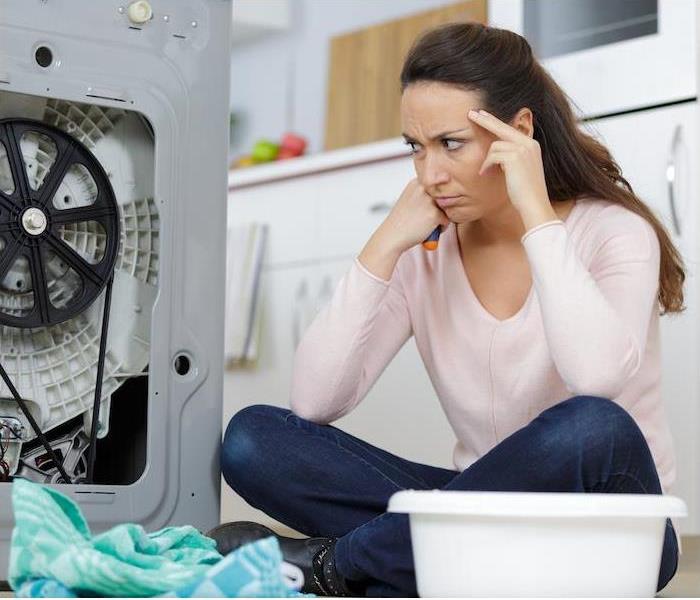 If your home experiences any flooding or other water issue, SERVPRO of Western Dutchess County is here to dry, clean and repair any damage.
If your home experiences any flooding or other water issue, SERVPRO of Western Dutchess County is here to dry, clean and repair any damage.
There is no water damage that is more or less pleasant to deal with, but discovering hidden damage can bring an extra layer of frustration.
Appliances are some of the most common culprits of this—they are often isolated or rarely moved, so discovering damage can be difficult. Thankfully, through regular check-ins, homeowners can stop this from getting out of hand.
Discover Appliance Leaks Through Regular ChecksHot Water Heater
A hot water heater will generally last around 10 years, but premature leaks are not uncommon from its pipes and seals. Making sure there is no diminished performance, standing water or other signs of water damage is a task that should be done with regularity to ensure damage does not occur.
Refrigerator
Refrigerators are some of the most rarely moved appliances, meaning water damage can lurk under and behind them long enough to become severe before it is even noticed. As part of your annual home maintenance, move the refrigerator away from the wall to look for any dark or soft spots with the wood, and test the water dispenser to watch for any drips.
Dishwasher
While refrigerators can cause issues, dishwashers pose an even higher risk and are moved about as infrequently. Dishwashers require gallons of water when they run and are not always covered by standard insurance policies. Because their leaks can be costlier and more severe, checking them as often or more than you check the fridge is advised.
Washing Machine
Washing machine hoses are some of the most common sources of leaks. Because they are notorious for this, it is recommended that they are inspected at least once a month by homeowners so you can be sure no issues have arisen. In addition to these regular checks, they should be fully replaced every five years in order to prevent hidden deterioration.
Air Conditioner
An air conditioning unit contains a drain that handles any accumulated condensation that is created when your unit is working. However, issues to this system can create hidden water damage quickly, as the condensation will pool inside the unit and can cause damage to surrounding structures. Your manufacturer’s maintenance schedule is the best defense against this—stick to it to be made aware of any issues before they start to cause serious problems.
If your home has been impacted by water damage or you’d like to put a plan in place in case it happens to you, contact us to learn how we can help.
Avoid Frozen Pipes in Your Fishkill Home!
12/17/2019 (Permalink)
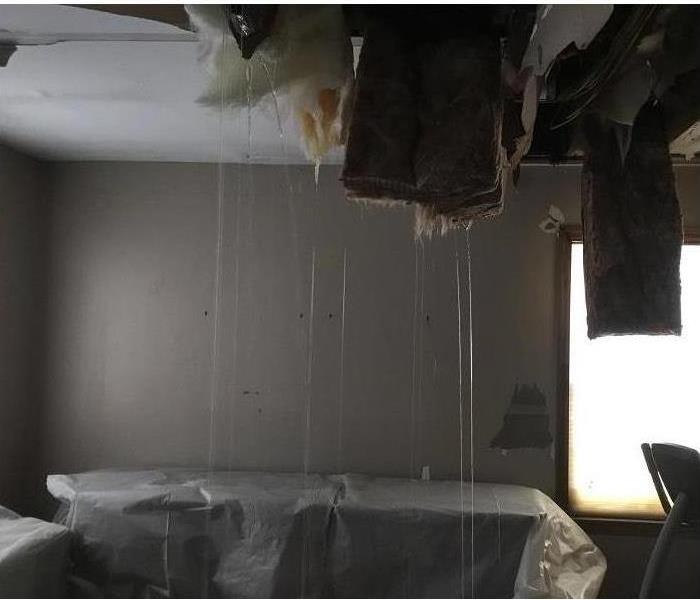 Some smart tricks and tips can help avoid frozen pipes in your Dutchess County home this winter!
Some smart tricks and tips can help avoid frozen pipes in your Dutchess County home this winter!
Subzero temperatures can cause even interior pipes to freeze. Burst pipes are one of the most common causes of property damage during frigid weather and can cause thousands in water damage.
Unheated interior spaces such as basements, attics, and garages are the first to cause problems. But even pipes running through cabinets or exterior walls can freeze. There are some simple things you can do to keep your water running and your house dry.
“Pipe insulation can cost as little as 50 cents per linear foot at your local hardware store,” says Susan Millerick, IBHS spokeswoman.“ So, for not much more than the cost of the aspirin you’d need, you can avoid the headaches of cleanup, loss of precious keepsakes, and the cost of your insurance deductible.” Use the pipe insulation liberally to protect any vulnerable pipes.
How to Beat the Freeze
Once the temperature starts dropping outside, you should take precautions inside to keep your pipes warm and water running. Temperatures below 20F are the warning spot so keep the area above that to thwart issues.
Keep the thermostat set to the same temperature during day and night. Not the best time to lower the heat to adjust for expenses as a water damage repair can be thousands of dollars to repair.
Open kitchen and bathroom cabinet doors to let warmer air to circulate around the plumbing. (If you have small children, be sure to remove any harmful cleaners and household chemicals.)
Let the cold-water drip from a faucet served by exposed pipes (think basement utility sinks or laundry sinks). Running water through the pipe, even at a trickle, helps prevent pipes from freezing.
Keep garage doors closed, especially if there are water supply lines in the garage. Consider some insulation around the windows and doors to help. This could help your whole house as well.
If you plan to be away during cold weather, leave the heat on in your home, set to a temperature no lower than 55° F. The last thing you want is to come home to an igloo.
For the long term, add insulation to attics, basements, and crawl spaces. Insulation will maintain higher temperatures in those areas. And to prevent drafts, seal cracks and openings around windows, doors, and at sill plates, where the house rests on its foundation.
How to Thaw Frozen Pipes
If you turn on a faucet and only a trickle comes out, you may well have a frozen pipe. If you think the pipes are frozen, be careful when thawing them out because if the pipe has already burst, the water will come flowing out and flood your home. If a pipe has broken, turn off the water at the main shutoff valve, which is usually at the water meter or where the main line enters the house. If the water is still running and no pipes have burst, you can take the following steps. (we usually recommend you call a plumber to avoid a much bigger problem.)
Turn on the faucet- Running water through the pipe, as cold as it is, will help melt ice in the pipe.
Apply heat to the section of pipe- using an electric heating pad wrapped around the pipe, an electric hair dryer, or a portable space heater (kept away from flammable materials), or by wrapping pipes with towels soaked in hot water. Do not use a blowtorch, a kerosene or propane heater, a charcoal stove, or any device with an open flame; the high heat can damage the pipes or even start a fire.
Apply heat until full water pressure is restored. Check all other faucets in your home to see whether you have additional frozen pipes. If one pipe freezes, others may freeze, too.
Sometimes, things just happen no matter how much you might prep, just keep in mind that SERVPRO of Western Dutchess County is here 24/7 for when water damage happens. Call us at 845-831-3600 and we'll make it "Like it never even happened."
24-Hour Emergency Water Damage Services for your Wappingers, Fishkill and Beacon home or business!
12/13/2019 (Permalink)
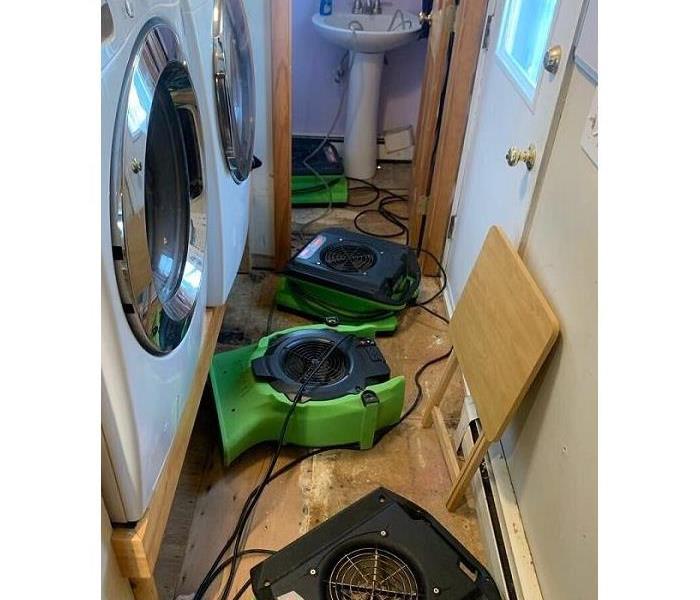 We're here to help 24/7 for all water damage emergencies!
We're here to help 24/7 for all water damage emergencies!
SERVPRO of Western Dutchess County provides 24-hour fire and water damage restoration services throughout Dutchess County including Wappingers, Fishkill and Beacon homes or businesses.
Our professionals are available 24 hours a day for water emergencies and we’re faster to any size disaster. When you are dealing with any kind of water damage, immediate action is crucial. A delay of just a few hours can greatly increase the severity of the water damage and sometimes cause secondary issues like mold growth.
We Answer the Phone Ready to Help,
Call Today - 845-831-3600
We understand that when you call us, you may be feeling confused, stressed, and overwhelmed. You need an expert to guide you through this crisis. Our staff has the specific water damage training and experience to help you through this tough time. We specialize in water damage restoration—in fact, it's the cornerstone of our business since 1992.
What You Can Expect
When you call, we will ask several questions regarding your water damage emergency. These questions will help us determine what equipment and resources to bring, including how many certified SERVPRO Professionals may be needed.
Some of the questions you can expect:
- Your name and contact information
- Your insurance information (if applicable)
- The street address of the water-damaged home or business
- When did the flooding or water damage occur?
- What caused the water damage and has the cause been repaired?
- Is there electricity and heat available (on-site)?
We’ll take it from there! We have a full staff of technicians ready to help at a moment’s notice, no matter the time or holiday!
About SERVPRO of Western Dutchess County
SERVPRO of Western Dutchess County specializes in the cleanup and restoration of residential and commercial property after a fire, smoke, water or sewage damage event. Our staff is highly trained in property damage restoration. From initial and ongoing training at SERVPRO’s corporate training facility to regular IICRC-industry certification, rest assured our staff is equipped with the knowledge to restore your property.
Let us help relieve the stress and make it “Like it never even happened.”
Key Difference Between Water and Flood Damage in your Dutchess County home
10/30/2019 (Permalink)
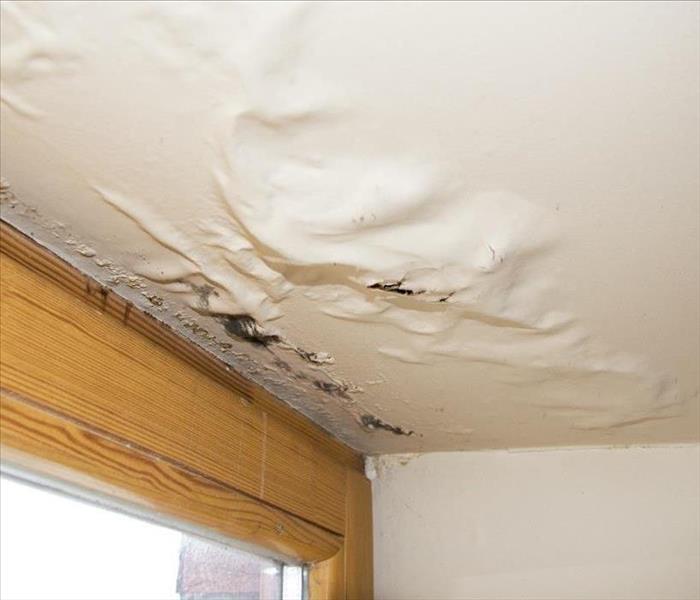 Know the differences between water and flood damage and make sure to know what your insurance covers and doesn't!
Know the differences between water and flood damage and make sure to know what your insurance covers and doesn't!
While “water damage” and “flood damage” are terms often used interchangeably, they actually have some key differences that are important as you begin the recovery process. While all Dutchess County water damages should be treated quickly, being aware of the cause of the damage will help tremendously as you begin restoration.
We’ve laid out the differences between flood and water damage, and have included some tips on how to stay protected from each type.
What Is a Flood? FEMA defines a flood as a temporary event that results in partial or complete water coverage on an area consisting of at least two acres or across at least two properties. If the water is caused by any of these sources, the chances are high that you’re dealing with flood damage:
* excess of inland or tidal waters
* any source of runoff or surface water that has accumulated quickly
* mudflow
*a collapse of land as a result of erosion or undermining, caused by excessive waves or currents that result in a flood
What Is Water Damage? Water damage and flood damage may seem quite similar, but their differences lie in their sources. You may have water damage instead of flood damage if:
* you are the only person affected * the water source is from inside your home * the water does not come from any sources listed above
If these factors apply, you may be dealing with water damage instead of flood damage. However, if two or more properties are involved or a large portion of your land is affected, you may be dealing with a flood instead.
Protect Against Water and Flood Damage Regardless of whether the damage is classified as being from a flood or from water, homeowners want to do their best to protect against it. Some of the ways you can do this are:
* Check areas prone to water damage regularly—basements, attics and bathrooms to name a few.
* Understand the flood alert system to be aware of your risks.
* Be aware of the types of flood insurance available to you, as it is typically not included in homeowner’s policies
If you’ve been affected by flood or water damage, we are here to help you. Call us 24/7 to get an immediate response to your restoration needs.
The Do's and Don'ts of Water Damage In Your Dutchess County home
10/16/2019 (Permalink)
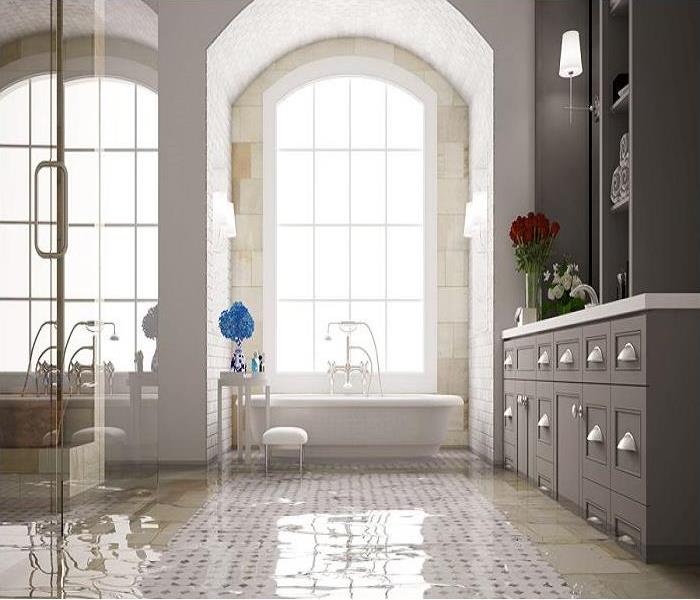 Stay safe and know what to do and what not to do following water damage in your home!
Stay safe and know what to do and what not to do following water damage in your home!
Sometimes, no matter how much you think you're prepared, things just happen. Pipes burst, appliances malfunction, sump pumps fail. If you experience water damage in your home from clean water (not sewage or contaminated waters), here's a few tips on what you should and shouldn't do before help arrives:
DO--If possible, shut off the water source. If not, call a plumber ASAP to get the source repaired. -Turn off circuit breakers for wet areas and ONLY when access to the panel is safe from electric shock.-Call your insurance company and submit a claim.-Call SERVPRO of Western Dutchess County, no matter the time or place, we'll be there to get the damage under control.-Remove excess water by mopping and blotting. Wipe water from wood furniture.-Prop up couch cushions, put blocks under furniture that might be sitting on wet carpeting.-Relocate any sensitive items like computers, paintings, and documents to a dry area. DON'T- (Safety is the biggest concern here)-Enter a room with standing water where there is a risk of electrical shock. Avoid areas where outlets, switches, electrical equipment or circuit breakers are exposed to water.-Use your household vacuum cleaner, these are not built for water and could cause electrical shock and damage the vacuum. Even a wet-dry vacuum can't handle more than a puddle, don't take the chance.-Use any appliances like TVs while standing on wet carpet or flooring, especially not on wet concrete floors! With any damage, safety comes first. Our professionals specialize in the cleanup and restoration of all Western Dutchess County properties from any kind of damage, leave it to the experts.We're here for your emergencies, 24 hours a day, 7 days a week and will make that water damage look "Like it never even happened."
Making the Right Choice in Restoration for your Water Damage
10/15/2019 (Permalink)
As a homeowner, a common reaction to unexpected water damage is being confused about what next steps to take. Between picking a restoration company to work with, consulting with home-owners insurance, assessing damage to personal items and taking care of other urgent tasks, it can be an overwhelming time.
However, by choosing a reputable and certified Dutchess County restoration company in advance, homeowners can mitigate at least one part of the process before it begins and feel some relief knowing that’s choice will make the whole process easier.
It can be difficult to determine what is important when researching restoration companies, which is why we’ve put together a guide of what to look for to make the right choice:
A Full Restoration Provider- Start to Finish
House damages, including water damage, not matter the cause, often require multiple types of restoration. Water can cause structural issues, while fire can require air purification due to soot. SERVPRO of Western Dutchess County is fully certified in every type of damage and can provide full restoration of your home.
Flexible Emergency Service
When you discover home damage, you want to be sure you can contact your restoration company right away. That is why we have a 24-hour, 7 day-a-week emergency line staffed by live people, not just a recording, so we can answer whenever you call and begin to assemble our team right away.
A Thorough Training Program
Technicians who perform restoration should be well-trained and highly skilled, which is why we use the highest standards in the industry to design our training materials and educate our technicians.
A Scalable Model
While we have been a LOCAL community business for over 25 years, we also have a nationwide network of other franchises that we can work with if a disaster were to occur. This allows us to treat every job with the same level of service and expertise, whether it is for a single home or an entire area.
If you have experienced storm damage, we are always here to help! Call our restoration experts 24⁄7 so we can address your damages quickly. We’ll help get you back to preloss condition, Like it never even happened.
Places to Check If You Have a Water Leak | SERVPRO® of Western Dutchess County
10/14/2019 (Permalink)
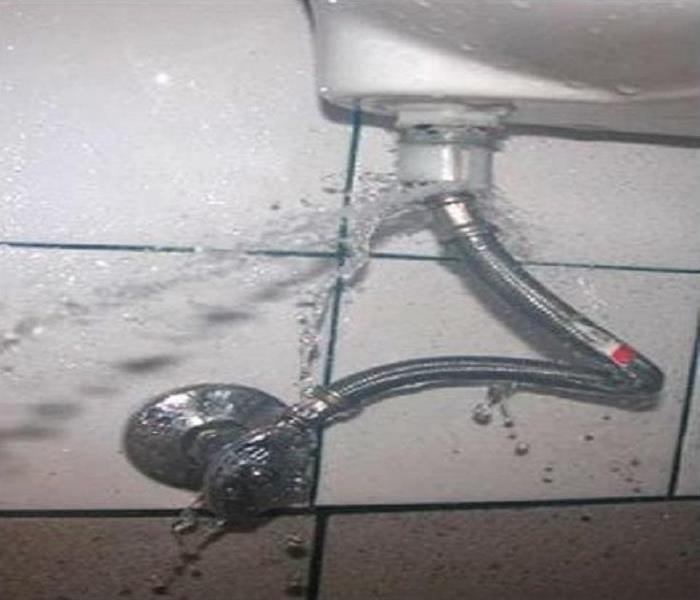 Some water leaks aren't obvious, make yourself a checklist of what to check and how often to avoid water damage situations in your Poughkeepsie home.
Some water leaks aren't obvious, make yourself a checklist of what to check and how often to avoid water damage situations in your Poughkeepsie home.
Water leaks do not always manifest themselves in dramatic spurts of water or puddles on the floor of your Poughkeepsie home. In fact, many people only find out there is a leak somewhere in their home once they notice a rise in their water bill.
A water leak can account for up to 10,000 wasted gallons of water a year, so you'll want to take care of them quickly. However, it can be difficult to determine where the leak is located ifthere are no obvious signs aside from an increase in your meter usage.
Checking for Water Leaks Around the Home
When trying to determine where your leak is located, checking the most obvious spots first will help you narrow your possibilities down by process of elimination. Here are some of the most common spots for water leaks:
- The Bathroom
Between the sink, toilet and shower, there are plenty of options for water to leak in the bathroom. Check the seal around the base of the toilet, ensure there are no drips from the faucet and check the pipes under the sink to rule the bathrooms out.
- Around the Hot Water Heater
Because it is normal for hot water heaters to build up condensation through regular operation, leaks can be difficult to detect at first. Listen closely for a leaking sound when the unit is off and watch moisture levels carefully to determine if this is the culprit.
- In the Basement
Most basements contain most of your home’s plumbing and water piping, so they are an important spot to check if you suspect a leak. Check the pipes thoroughly where they seal for any accumulated moisture.
- Beneath and Behind Appliances
Appliances such as refrigerators, dishwashers and washing machines utilize a lot of water and are susceptible to leaks from damaged pipes. Check under and behind appliances regularly for moisture buildup.
- Under the Kitchen Sink
Kitchen sinks, especially those equipped with garbage disposals, are notorious for leaking water into the cabinet underneath. There are many seals and connectors that can wear down with age, causing an unseen leak to hike your water bill up.
Life happens, if you’ve discovered water damage in your home, that’s what we’re here for! We’ve got the experts in the industry and can restore water damage to just about any surface— contact us today for a quick response!
Protect your Western Dutchess County home from Ice Damming before it becomes a problem!
10/10/2019 (Permalink)
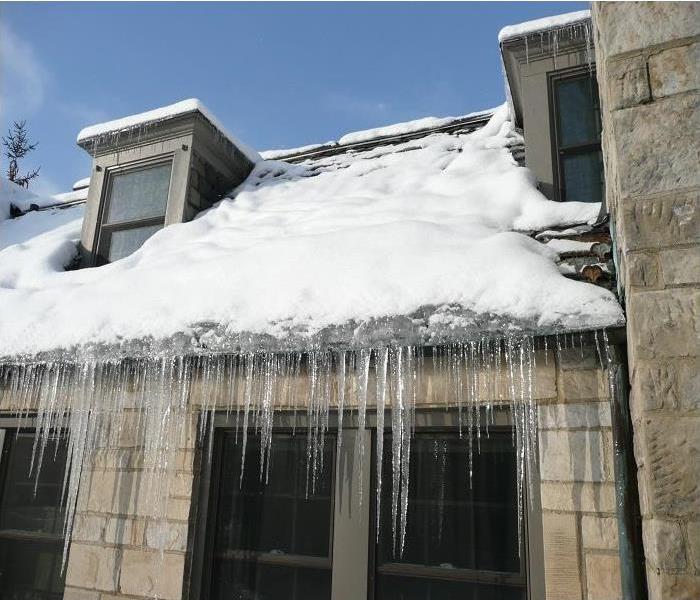 All this snow and ice build up is an ice damming issue ready to happen! Take care in the Fall to help prevent water damage in the Winter!
All this snow and ice build up is an ice damming issue ready to happen! Take care in the Fall to help prevent water damage in the Winter!
Fall is the ideal time to get your Poughkeepsie, Fishkill, Beacon and Wappingers homes ready for winter. Most of us have heard the stories about ice damming from a roof or gutters, it’s a stressful and costly headache that can be prevented.
Ice dams can occur when there are several inches of snow on the roof and the outside air temps hover in the low 20’s for many days. Poor attic insulation increases the chances of a problem. Ice dams form when heated air melts roof snow down into water stuck behind still frozen ice. When the water is dammed and has nowhere to flow through the gutter system, it can back flow under shingles and inside your home. The bottom line is you want to try to keep that attic as cold as you can to stop melting ice AND to keep the snow and icicles clear from your roof.
Here are some helpful prevention tips you can do ahead of winter to avoid an ice damming problem:
- Keep the attic air temperature below freezing when the outside air temperature is in the low 20’s.
- Install more insulation in the attic floor to prevent warm household air getting into the attic.
- Have good ventilation in the attic to consistently replace warm air that might rise to the attic with cold outside air.
- Keep the bottom 4-6 feet of your roof clear of snow but be careful not to damage any shingles.
- Make sure your gutters are clear of leaves and debris. The more clogged they are, the higher the chances of the heavy ice build-up happening.
- Check and seal places where warm air could leak from your house to the attic: vent pipes, exhaust fans, chimneys, attic hatches and light fixtures are all possibilities.
- Consider installing a heat cable along the eaves to help melt the ice.
- Inspect, or have your roof and attic inspected for proper ventilation and insulation.
- Look for signs of inadequate ventilation: rust spots, rusty nails or a mildew smell are all signals that moisture has formed on the inside of your roof.
- If you have soffit vents in your eaves, make sure they are not blocked and insulation surrounding them is secured so that air can flow easily.
If ice damming does occur despite your best efforts, keep in mind the following:
-Don’t chip away at the ice, that will damage the shingles no matter how hard you try not to.
-Don’t install a water heater or other mechanical equipment in the attic.
-Don’t use salt or calcium chloride to melt the snow, they are super corrosive and can cause problems with gutters, downspouts and flashings. The runoff from these will also cause harm to plants and grass.
The best solution is to call a roofing specialist to locate the leak and seal everything. Then call SERVPRO of Western Dutchess County to remediate the water damage. We’re available for emergencies 24/7 at (845)831-3600. Our certified water damage technicians will work to get your home back Like it never even happened.
Classifying Types of Water in a Damage Event in Western Dutchess County
10/9/2019 (Permalink)
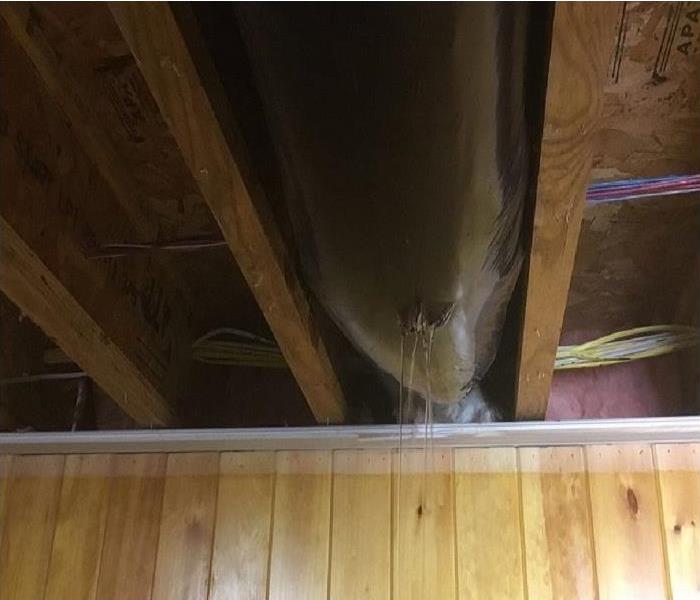 Let the experts in water damage restoration take care of restoring your property!
Let the experts in water damage restoration take care of restoring your property!
NOT all types of water cause the same damage as there are 3 classifications or categories: clean water, gray water and black water.
The 1st step is always the same, clean up the water, dry everything out as soon as possible to avoid the threat of mold growth. The methods and procedures of the dry out are determined by the experts at SERVPRO of Western Dutchess County:
1: Clean Water
Clean water doesn’t pose an immediate threat to your health. Clean water is free of contaminants, fewer microbes and may be the result of broken water lines, toilet holding tanks, appliances and snow melt or rainwater.
However, it only takes 48 hours and contact with the surfaces of a home for clean water to become a category 2, Gray Water.
2: Gray Water
Gray water means the water damage cleanup and restoration can become a bit more serious. This water may create a health risk since it will contain degrees of chemical, viral or biological contamination. It has the potential to cause illness if contacted or consumed.
Gray water occurs from toilet bowls, sump pump failures, dishwashers, aquariums, washing machines and showers. The 48-hour exposure time applies here as well, since gray water becomes black water if not treated.
3: Black Water
Where there is black water, you now have the most serious of the three classifications, and it is considered highly or grossly contaminated by harmful chemicals, fungi and biological matter and will cause severe discomfort and illness. The sources are toilet back flows, sewage, seawater, rising water from rivers or streams, ground surface water or standing water.
It is best to treat all waters associated with water damage as black water because water picks up contaminants along its path. Consider the example of water running inside the sheet rock walls and insulation of your home.
The three classifications of floodwater are recognized by the Institute of Inspection, Cleaning and Remediation Certification (IICRC), an organization that certifies and sets the standards for the cleaning and restoration industries. Our technicians are certified by IICRC standards and best practices in water restoration and are available to help determine the steps to take to get your home back to normal.
It doesn’t matter what type of water has caused damage to your home or business, SERVPRO® of Western Dutchess County is here to help get the situation under control. Don’t hesitate to reach out to us if you need emergency cleanup and restoration services! Call us at 845-831-3600.
Where Hidden Water Damage Can Be Found | SERVPRO® of Western Dutchess County
9/24/2019 (Permalink)
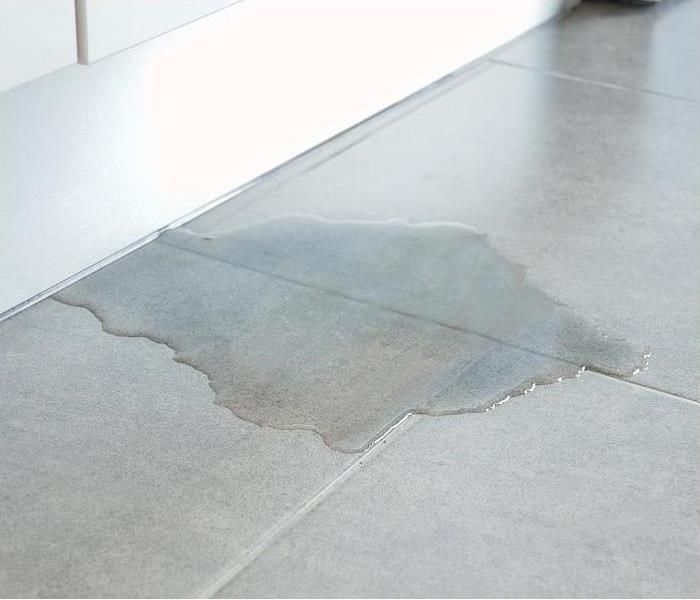 You'd be surprised how much damage water can do! Be familiar with the terms of your homeowner's insurance policy and call SERVPRO right away!
You'd be surprised how much damage water can do! Be familiar with the terms of your homeowner's insurance policy and call SERVPRO right away!
While extreme rains and heavy flooding will increase the chances of water damage, these are not the only reasons it will occur. Many things in the home can cause water damage, and quite a few of them occur in places that are easily missed.
If water damage is left untreated, it can become more severe, which is why hidden water damage is so dangerous. Most water damage claims are more than $6,500, and it’s not uncommon for insurance to not accept water-related claims at all. Knowing where to find hidden water damage can make a big difference in how much of a headache it will be to treat.
Where to Look for Water Damage
- Below exterior windows- The seal around a window is not the most durable piece of construction, so it can slowly begin to let water seep into the wood below with time.
- Connection points of siding- Where siding overlaps or meets a corner, it is sealed against the elements. However, damage to the siding can also mean damage to the seal, leaving the plywood below exposed to water.
- Below threshold panels- Thresholds are typically covered by a metal panel, but this panel is not water-tight. If it is frequently exposed to weather, the wood below can become waterlogged and swollen eventually.
- Exterior painted surfaces- Multiple layers of paint can form miniature gaps between them, letting water in and causing the paint to bubble or soften.
- Within dishwasher cubbies- It is not typical to move the dishwasher unless it is being replaced, but often homeowners discover water damage during the upgrade process. Inspecting it regularly will help ensure there are no surprises.
- Inside bathroom walls- Water pipes heading toward the sink or tub can begin to leak with time, causing water spots in the paint as the water seeps into the wall.
- Around toilets- A toilet has many seals to keep water in, but these can become weaker with time. Many homeowners will not notice until the floor begins to feel unsteady and the toilet develops a wobble.
If your home has suffered water damage (even in a hidden place like one of these), we are happy to help! SERVPRO of Western Dutchess County has certified water remediation experts, don't wait! Give us a call right away, and we’ll get there quickly.
Immediate Dangers After a Flood | SERVPRO® of Western Dutchess County
6/24/2019 (Permalink)
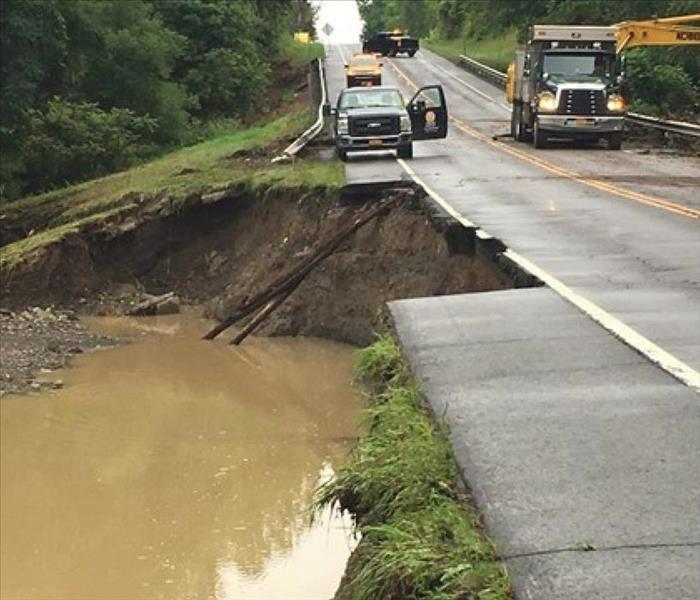 There are dangers lurking in flood waters, know what you could be dealing with!
There are dangers lurking in flood waters, know what you could be dealing with!
With rising waters and potential structural damage, the initial start of a flood is a dangerous time. However, after the rain stops in Western Dutchess County and the skies clear, there are still hazards that can lurk in the floodwaters.
Potential Dangers
It is important to be aware that the dangers do not stop after the water ceases to rise. Here are three dangers that are present in the immediate time after a flood:
Damage to Utility Lines
Floodwaters can cause damage to electrical power lines, as well as propane or gas sources according to the Centers for Disease Control. If it is safe to do so, you can turn off these utilities to minimize fire hazards—but if the main control requires you to access it through water, it is best to call an electrician.
Contact with Dirty Water
Floodwater can mix with sewage or hazardous substances, as well as hide power lines or dangerous objects in its depths. This dangerous water can lead to infection in open wounds, and ingesting it can pose serious health risks. Because of these dangers, it’s best to consult the experts when it is time to clean up.
Contact with Moving Water
No matter how shallow it is, never try to walk or drive through flowing water. It can take as few as six inches of water for drivers to lose control of vehicles or to knock an adult off his or her feet.
The Aftermath of Flooding
Following these immediate dangers, in the days and weeks after a flood, it is important to be vigilant about mold growth. An area affected by a flood poses the ideal environment for mold to grow, and it only takes a single spore to start an infestation. Proper mold remediation is essential after a flood to prevent future issues and keep the air in your home healthy.
If you need help with flood cleanup or mold remediation at your home or business in Poughkeepsie, Fishkill, Wappingers or Beacon, we’re here for you! Call us today, we’re here to help and will make any damage situation “Like it never even happened.”
Safety first when dealing with water damage at your Western Dutchess County home
6/18/2019 (Permalink)
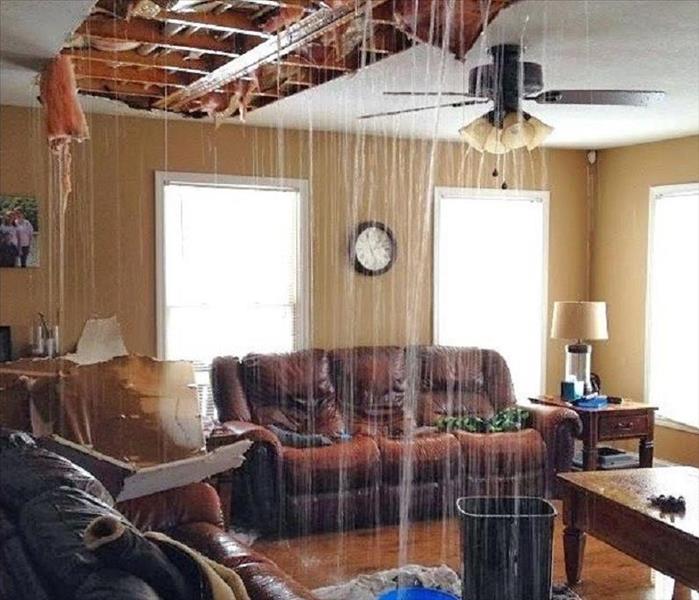 The weight and force behind water are just some of the reasons it causes the most damage to properties.
The weight and force behind water are just some of the reasons it causes the most damage to properties.
If you find yourself dealing with a water damage emergency at your Western Dutchess County property, many questions are running through your mind. When you’re looking at the reality of the situation, it’s common to want to get everything fixed immediately, but safety is key and there are some important points to be aware of during this overwhelming time:
DO:
-Shut off the source of the water if possible or contact a qualified party to stop the water source.
-Turn off circuit breakers for wet areas of the home or building, but ONLY when access to the power distribution panel is safe from electric shock.
-Call us as soon as the water is off and you’re safe, (845)831-3600, no matter what time of day. We’re faster to any size disaster.
-If you can, remove as much excess water as possible by towels and mopping.
-Remove lamps and tabletop items to a dry spot, try to wipe excess water from wood furniture.
-Relocate and prop up wet couch cushions and pillows.
-If you have any paintings, art objects, computers, documents, paperwork, publications and other materials that are valuable or sensitive to moisture, get them to a safe and dry spot quickly. Leaving books, newspapers, magazines or other colored items on wet carpets or floors can cause staining. We can help dry out all of them items too. Our “restore vs. replace” methods will help keep the costs down as well to both you and your insurance company.
DON'T:
*DO NOT enter rooms with standing water where electrical shock hazards may exist.
*AVOID electrical shock hazards. DO NOT enter affected areas if any electrical outlets, switches, circuit breakers or electrical equipment are exposed to water.
-Your household vacuum cleaner is not built to remove water. Don’t ever bother as it could possibly cause electrical shock or damage to the vacuum cleaner.
-Anything electrical is going to be a hazard right now. Don’t use TV's or other appliances while standing on wet carpets or floors, especially not on wet concrete floors.
-Same with ceiling fixtures, leave them alone. If the ceiling is wet or if water has entered rooms where ceilings are sagging from retained water, it’s dangerous to try your ceiling fan.
Safety is first and foremost when it comes to water damage in your home. Following these DO & DON'Ts can help reduce damage and increase the chances of a successful restoration. These emergency tips will assist you in taking the proper action until the SERVPRO of Western Dutchess County trained professionals arrive. We’re here to help!
What to do in your Western Dutchess County home if you discover water damage!
4/18/2019 (Permalink)
 Water stains in your ceiling mean water is leaking somewhere!
Water stains in your ceiling mean water is leaking somewhere!
There really are a few key FAQ's to know if you've had water damage in your home in Western Dutchess County:
What do I do first? W
When it comes to water damage, the cause of the loss must be repaired first. Call a plumber to get the problem repaired right away.
We highly recommend you then file a claim with your insurance company.
Then, call SERVPRO of Western Dutchess County, no matter the size of the disaster and no matter what time of day. Our dedicated professionals will gather all needed information and schedule an estimator to meet you.
How much is this going to cost me?
Our estimates are FREE and we work directly with your insurance company to help cover the costs of the damage. In most cases, you’re only responsible for your insurance deductible. However, no two losses are ever the same, we’re happy to explain the course of action.
What about the damaged items? O
Our teams are trained and certified in Water Damage Restoration. They will remove all damaged contents that are salvageable, clean and dry them and return them to you promptly. We have state of the art drying equipment to take care of it all from couches to clothing to important documents, photos and electronic equipment.
Do I have to worry about mold?
Fixing the leak and drying out all affected areas in quick fashion helps stops the growth of mold spores. Mold likes warm and damp environments, that’s why you’ll often see it in basements, crawl spaces and sometimes attics. As part of our drying process, we use green- based anti-microbial products to inhibit any mold growth, in addition to SERVPRO’s proven mold prevention techniques and protocol. Time is key here, the quicker the areas are remedied, the less of an issue mold growth will be.
How long does this whole process take?
This often depends on the size and severity of the damage but our estimators, production managers and technicians will be with you step by step. We pride ourselves in using effective methods as well as being efficient and timely. We understand how stressful this type of situation is and we’re eager to help get your life back to normal as quickly as possible.
We've got your back no matter what and we'll help make it "Like it never even happened." 845-631-3600
How bad could water damage be? When Water Attacks: a SERVPRO of Western Dutchess County story
3/19/2019 (Permalink)
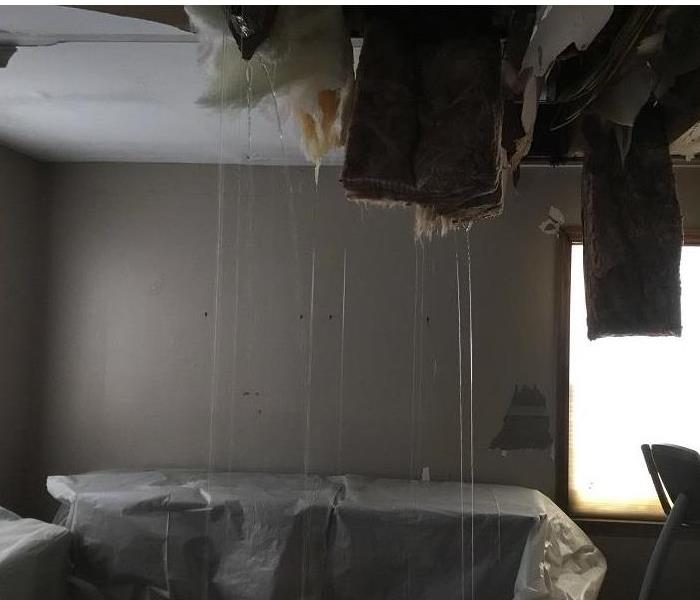 Once the heat was fixed, this once-frozen insulation became a nasty waterfall.
Once the heat was fixed, this once-frozen insulation became a nasty waterfall.
You're enjoying a well-deserved tropical vacation when you get a call from a relative checking on your home….it's 10 degrees there, pipes in your attic have burst and what seems like your entire home has water damage from top to bottom.
It's not just a wet floor that will dry, WATER DOES THE MOST DAMAGE and will find whatever way it needs to get out. Insulation, sheet rock, everything gets soaked and then gravity and weight take over. Before you realize it, every surface, every item, just about everything you have has some sort of debris, dust, moisture, bits of sheet rock and insulation on it.
This type of damage needs to be remedied quickly before secondary issues arise. Heating/plumbing systems fixed, everything needs to be dried out from floors to walls to ceilings, including removal of the damaged areas. Personal items and contents must be relocated elsewhere, cleaned and stored, and then reconstruction can start.
Thankfully, SERVPRO of Western Dutchess County was able to start remediation services right away and the homeowner will be able to resume their vacation very soon. We’re with you every step of the process, to make it better than new, to make it "Like it never even happened."
Understanding How Floodwaters Are Classified | SERVPRO® of Western Dutchess County
2/25/2019 (Permalink)
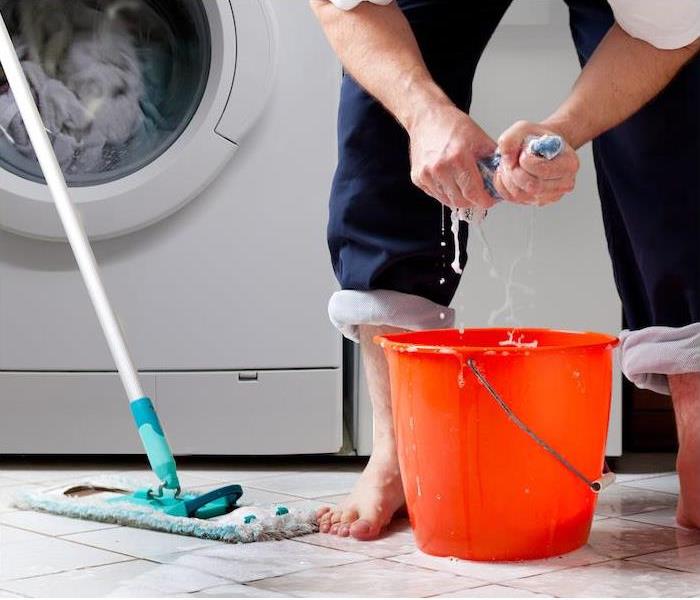 Know the different types of flood water!
Know the different types of flood water!
Even though it is easy to consider all water that causes damage the same, there are three separate classifications: clean water, gray water and black water. You can better understand how to handle a water damage situation by having an understanding of the differences in these types of water.
The basics are the same. It doesn’t matter what type of water has caused damage because a cleanup and restoration process will always follow. First, and most important, is removing all moisture and damp items as quickly as possible, to hinder the growth of mold, which begins to flourish in this ideal environment.
1: Clean WaterMuch like its name suggests, clean water is just that, “clean,” and not the type to pose an immediate threat to your health. Clean water is free of contaminants and may be the result of:
- Broken water lines
- Malfunctioning appliances
- Toilet holding tanks
- Snow melt and rainwater
Clean water is the easiest type of water damage to work with because there are fewer microbes living in the water. But remember, it only takes 48 hours and contact with the surfaces of a building for clean water to become a category two, gray water.
2: Gray WaterGray water means the water damage cleanup and restoration can become a bit more serious. This water may create a health risk since it will contain slight chemical or biological contamination.
This slight contamination involved with gray water will mean that it will need to be thoroughly treated before safe consumption.
Gray water includes water from dishwashers, aquariums, showers, etc. The 48-hour exposure time applies here as well, since gray water becomes black water if not treated.
3: Black WaterWhere there is black water, you now have the most serious of the three classifications, and it is considered highly contaminated by harmful chemicals and biological matter. This type of water would be floodwaters containing soil and all sewage waters.
Sewage is contaminated with dangerous microbes, including bacteria, protozoans, molds, fungi and more, which are harmful to humans.
Some of the diseases that can be transmitted by black water are:
- Cholera
- Typhoid
- Hepatitis
- Gastroenteritis-type illnesses
It is best to treat all waters associated with water damage as black water because water picks up contaminants along its path.
The three classifications of floodwater are recognized by the Institute of Inspection, Cleaning and Remediation Certification (IICRC), an organization that certifies and sets the standards for the cleaning and restoration industries. Our technicians all study IICRC standards and best practices in water restoration and are available to help determine the steps to take to get your home back to normal.
It doesn’t matter what type of water has caused damage to your home or business, SERVPRO® of Western Dutchess County is here to help get the situation under control and make it "Like it never even happened." Don’t hesitate to reach out to us if you need emergency cleanup and restoration services! Call us at 845-831-3600.
Tips to Help Protect Your Home From Water Damage | SERVPRO of Western Dutchess County
2/15/2019 (Permalink)
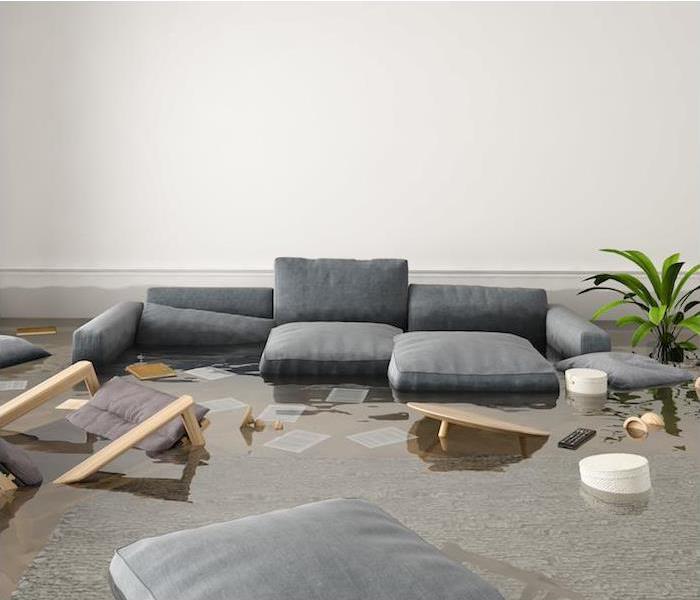 Water damage can be one of the costliest damages to experience in a home or business.
Water damage can be one of the costliest damages to experience in a home or business.
Water damage has proven to be one of the most costliest yet common disasters a home can experience. From a burst pipe to a malfunctioning dishwasher or storm damage, there are countless ways water damage could occur in your home.
While water damage can be an especially common issue for homeowners to deal with, there are plenty of ways you can help protect your home.
Protecting Your Home From Water Damage
Water damage is a huge hassle to deal with, it can have a long-term impact on your home, one of them being mold. It’s one of the most common side effects of water damage because it begins to grow and flourish within 48 hours of exposure to moisture.
When beginning to think of ways to safeguard your home against water damage, it might be easier if you break it down by areas of impact. These areas could include basements, kitchens, bathrooms, flooring and ceilings.
In the basement, you can prevent water damage by preventing water seepage. Do this by resealing vulnerable areas of the basement, making sure water drains away from your home and installing a backwater valve.
Your kitchen and bathrooms can experience water damage due to plumbing issues and appliance failures.
Be sure you:
- Inspect your appliances regularly, especially the hoses and faucets
- Check to make sure there are no leaks in the seals or caulking around your showers and tubs
- Know where the main water shut-off valve is in your home
- Don’t leave the house while the washer or dishwasher is running
There are things you can do to protect the possessions in your home from water damage, but don’t be surprised if it is not always possible. Use waterproof bins to store items and keep items stored on shelves up off of the floor.
How to Clean Up After Water Damage
If your home does experience a water damage situation, there is a good chance you can salvage items that can be dried out within 48 hours.
Be sure that you contact your insurance company immediately after the water damage situation and evaluate the extent of the water damage in your home as well as identify the type of water that is involved.
The three types of water are:
“Clean” water. Can be from rain, condensation, leaky pipes, etc.
“Gray” water. Slightly dirty water from dishwashers, washing machines, clean toilets, etc.
“Black” water. Water from sewage or serious flooding from nearby rivers, etc. This water can cause serious health problems.
Removing all wet items from your home and getting it dehumidified and dried out after a water damage disaster is important. You will then need to thoroughly clean and disinfect all remaining materials.
Here’s a tip from the pros: Freeze wet books, photos and papers in a frost-free freezer, allowing you extra time to deal with them after everything else has been taken care of. This prevents mold and mildew from developing and causing more deterioration. Once able, remove them from the freezer and air-dry or fan-dry the pages.
It may seem like recovering from water damage is an overwhelming and slightly impossible task, but it doesn’t have to be. You can call on the highly trained experts at SERVPRO® of Western Dutchess County, at 845-831-3600. We are here to make it "Like it never even happened!"
Do you own a vacant home? Best practices for avoiding frozen pipes
2/5/2019 (Permalink)
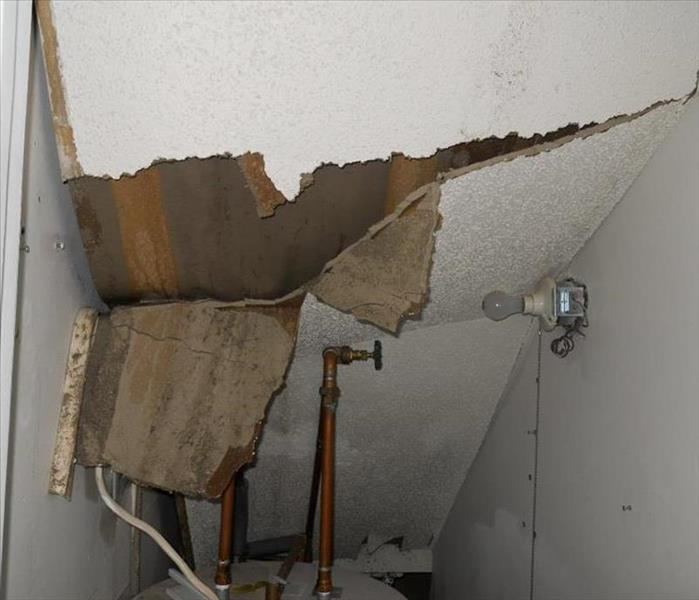 Avoid this damage by preparing your vacant property for winter temps!
Avoid this damage by preparing your vacant property for winter temps!
If you own a 2nd home, rental property or have a vacant property for sale, it's important to have it winterized before the winter starts and to have someone available to check on it for you while it's vacant.
While there are always unforeseen issues that can happen, it's the water that causes the most damage. Water can and will get into everything, continuously finding a way out is the name of the game.
Don't turn the heat off in the colder months, follow good instructions to protect your pipes and utilities, have your furnace and heating systems checked regularly, seal windows and doors if possible, check outside spigots and water sources. Speak with your insurance agent about tips they have and make sure your policy is where it needs to be.
Should you ever suffer from water damage, or any kind of loss to your property, call the experts in damage restoration. SERVPRO of Western Dutchess County has been the local leader in the industry for over 25 years, we're here for your emergency 24/7 with certified technicians and the best technology around.
Call us immediately so we can give you piece of mind quickly, no matter the damage and no matter the size, 845-831-3600.
It's Frozen Pipe Season! Follow These Handy Tips to Avoid a Serious Problem!
12/28/2018 (Permalink)
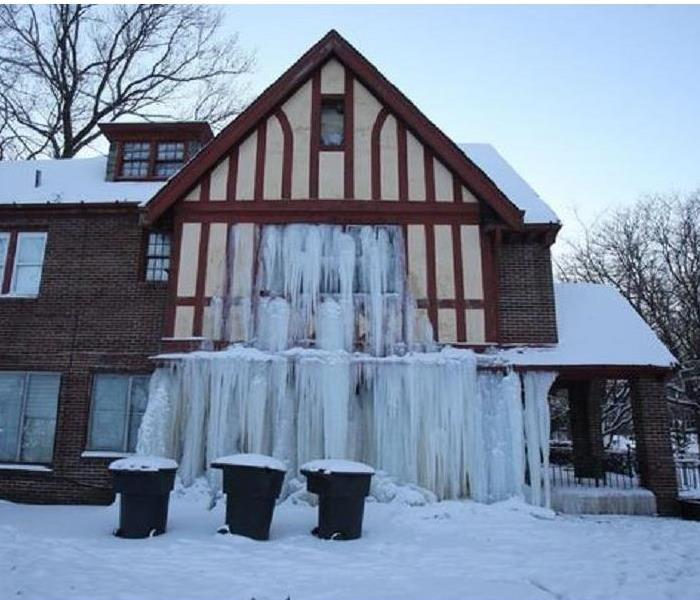 This is an extreme example of how much damage frozen pipes can do to your home.
This is an extreme example of how much damage frozen pipes can do to your home.
Subzero temperatures can cause even interior pipes to freeze
When temperatures plummet, the risk of your pipes freezing and bursting skyrockets. In fact, burst pipes are one of the most common causes of property damage during frigid weather and can cause thousands in water damage—easily $5,000 or more, according to the Insurance Institute for Business and Home Safety (PDF).
The pipes most at risk are those in unheated interior spaces such as basements, attics, and garages. But even pipes running through cabinets or exterior walls can freeze. The good news is there are some simple things you can do to keep your water running and your house dry.
“Pipe insulation can cost as little as 50 cents per linear foot at your local hardware store,” says Susan Millerick, IBHS spokeswoman. “So for not much more than the cost of the aspirin you’d need, you can avoid the headaches of cleanup, loss of precious keepsakes, and the cost of your insurance deductible.” Use the pipe insulation liberally to protect any vulnerable pipes.
Both the IBHS and the American Red Cross, which is in the business of emergency preparedness, have useful advice on how to prevent your pipes from freezing, as well as how to thaw them if they do.
How to Beat the Freeze
Once the temperature starts dropping outside, you should take measures inside to keep your pipes warm and water running. Research conducted by the Building Research Council at the University of Illinois shows that the “temperature alert threshold” is 20° F, especially if you have uninsulated pipes running through an uninsulated space.
Some of the steps experts recommend may go against your better instincts of conserving water and heat, but the extra expense is nothing compared with a hefty repair bill. Here’s what to do:
Keep garage doors closed, especially if there are water supply lines in the garage.
Open kitchen and bathroom cabinet doors to allow warmer air to circulate around the plumbing. (If you have small children, be sure to remove any harmful cleaners and household chemicals.)
Let the cold water drip from a faucet served by exposed pipes. Running water through the pipe—even at a trickle—helps prevent pipes from freezing.
Keep the thermostat set to the same temperature during day and night. Again, during a cold snap is not the time to set back the thermostat at night to save a few bucks on your heating bill.
If you plan to be away during cold weather, leave the heat on in your home, set to a temperature no lower than 55° F.
For the long term, add insulation to attics, basements, and crawl spaces. Insulation will maintain higher temperatures in those areas. And to prevent drafts, seal cracks and openings around windows, doors, and at sill plates, where the house rests on its foundation.
How to Thaw Frozen Pipes
If you turn on a faucet and only a trickle comes out, you may well have a frozen pipe. “If you suspect the pipes are frozen, be careful when thawing them out because if the pipe has already burst, the water will come flowing out and flood your home,” says John Galeotafiore, who oversees Consumer Reports’ testing of home products and power gear.
If a pipe has broken, turn off the water at the main shutoff valve, which is usually at the water meter or where the main line enters the house. If the water is still running and no pipes have burst, you can take the following steps. (Of course, if you suspect a more serious problem, call a plumber.)
Turn on the faucet. As you heat the frozen pipe and the ice plug begins to melt, you want the water to be able to flow through. Running water through the pipe, as cold as it is, will help melt ice in the pipe.
Apply heat to the section of pipe using an electric heating pad wrapped around the pipe, an electric hair dryer, or a portable space heater (kept away from flammable materials), or by wrapping pipes with towels soaked in hot water. As tempting as it may be, do not use a blowtorch, a kerosene or propane heater, a charcoal stove, or any device with an open flame; the high heat can damage the pipes or even start a fire.
Apply heat until full water pressure is restored. Check all other faucets in your home to see whether you have additional frozen pipes. If one pipe freezes, others may freeze, too.
Call a licensed plumber if you are unable to locate the frozen area, if the frozen area is not accessible, or if you cannot thaw the pipe.
Careful with that space heater!
If you need a space heater, use it safely. If you need supplemental heat, you can add a space heater to a room where pipes may be at risk. And though we don’t recommend using a space heater in a bathroom, if you really need one, make sure it’s plugged into an outlet with a ground-fault circuit interrupter and do not use an extension cord.
Sometimes, no amount of prep and prevention can stop situations like this, just remember that SERVPRO of Western Dutchess County is here 24/7 for when water damage happens. Call us at 845-831-3600 and we'll make it "Like it never even happened."
reference: Consumer Reports, How to Prevent Your Pipes From Freezing, https://www.consumerreports.org/home-maintenance-repairs/how-to-keep-pipes-from-freezing/
These Things Could Lead to Water Damage in Your Home | SERVPRO® of Western Dutchess County
12/7/2018 (Permalink)
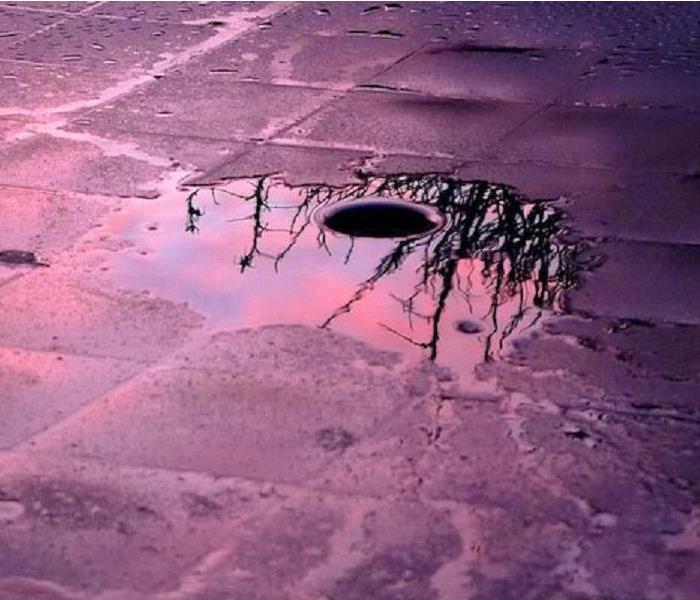 Severe weather is not always the main culprit in causing water damage.
Severe weather is not always the main culprit in causing water damage.
What is the first thing that comes to mind when you think about water damage? When thinking about water damage, severe weather is usually one of the first things that comes to mind, and while storms and flooding certainly can cause catastrophic water damage, they are often not the main culprits.
Instead, many items in your home could be responsible for many situations that result in water damage.
Understanding Water DamageWater damage is something that many homeowners will face. It was the third most common reason that homeowners filed a homeowners insurance claim between 2011 and 2015, with an average payout per claim of $8,861.
There is a difference between water damage and gradual damage, which can impact insurance claims. Gradual damage is something that has been happening over time, such as plumbing issues in the walls causing damage to the walls, ceilings or floors, or water damage caused by cracks in the foundation, for example. Sadly, many claims for gradual water damage are not covered by homeowners insurance, while storm-related water damage usually is.
Common Water Damage CulpritsAccording to the Insurance Institute for Business & Home Safety (IBHS), the leading causes of water damage are:
Plumbing supply system failures. This happens when pipes freeze and burst due to the buildup in water pressure caused by freezing water or when the supply system material fails, resulting in leaking or bursting pipes. Per IBHS, plumbing supply system failures are the leading source of residential water damage losses, and the average cost was $5,092 per incident after the deductible. It was also found that homes 16 to 40 years of age made up a larger group of supply system material failure claims.
Plumbing drain system failures. Sewer drains can back up and overflow into a home due to drains backing up and overflowing into a home or from material malfunction issues. In their study, IBHS found that 52% of drain system failures were caused by sewer backups and 37% were related to material performance issues—and they also noted that the average drain system failure caused more expense in southern region states than in northern region states.
Toilet failures. Toilet failures are the second largest source of residential water loss after plumbing supply system failures, and can result from faulty fill valves or clogged drain lines. According to IBHS, toilet failures that happen on the first floor of a home were the reason for more extensive claims than those that happened in basements or upper floors.
Water heater failures. Water heaters only last for so long, and if your water heater has reached its life expectancy, the tank will eventually begin to rust and corrode, resulting in leaking or bursting issues. IBHS found that slow leaks or sudden bursting were the cause for 69% of all water heater failures and, on average, cost $4,444 per incident following the deductible.
Washing machine failures. Washing machine failures can typically be caused by supply hose failures, machines overflowing and drain line failures. This type of failure is listed as one of the top 10 sources of residential water damage losses. Per IBHS, supply hose failures were the culprits for over half of all washing machine-related losses.
If your home has experienced any water damage, the team at SERVPRO® of Western Dutchess County is available to help with cleanup and restoration and make it “like it never even happened.” Call us at 845-831-3600.
Ice Damming Tips for your Dutchess County home- before it's a problem-
10/30/2018 (Permalink)
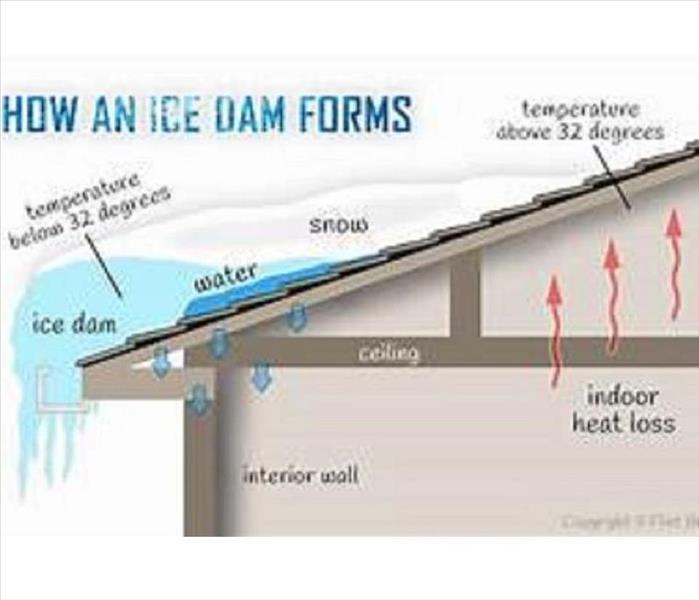 Learn how to avoid ice damming before it becomes a problem.
Learn how to avoid ice damming before it becomes a problem.
What is ice damming?
What is an ice dam? Ice dams form when heated air melts roof snow downward behind still frozen ice. When the water that is trapped cannot flow or run through the gutter system, it can back flow under the roof shingles and into your home's interior areas.
When will ice dams occur?
- The right weather conditions for ice damming is usually when outside air temperatures are in the low 20s (F) for several days with several inches of snow on the roof.
- If you have poor attic insulation, your chances of ice damming drastically increases.
How do I prevent ice dams?
- Keep the attic air temperature below freezing when the outside air temperature is in the low 20s. This can reduce the occurrance of ice dams.
- Lay more insulation down on the attic floor to prevent the warm household air from penetrating into the attic.
- Provide good attic ventilation to replace warm air in the attic with cold outside air.
- Keep the bottom four feet of the roof clear of snow. Be careful not to damage the shingles.
What NOT to do!
- DO NOT attempt to “chip away” the ice of an ice dam. It will likely lead to shingle damage
- DO NOT install mechanical equipment or water heaters in attics, especially in cold climates.
- DO NOT use salt or calcium chloride to melt snow on a roof. These chemicals are very corrosive and can shorten the life of metal gutters, downspouts and flashing. Runoff that contains high concentrations of these chemicals can damage nearby grass and plants.
Call our SERVPRO of Western Dutchess County office today if you have any questions or concerns about ice damming!
In the event you have water damage in your home from ice damming, we are available to help 24/7 at 845-831-3600!
It's starting to get cold out there, check out these tips to help avoid broken pipes in your Western Dutchess County home!
10/29/2018 (Permalink)
 A broken pipe can cause extensive water damage.
A broken pipe can cause extensive water damage.
t's getting very cold out there and winter is upon us! Don't be caught with broken pipes and water throughout your home! Here are some tips from the Insurance Information Network of California (2013) to prevent this from occurring:
1. Disconnect all garden hoses and other outside hose connections. If possible, use an indoor valve to shut off and drain water from pipes leading to outside faucets.
2. Insulate all exposed pipes located in your basement, under your home, on outside walls or in attics. For pipes with northern exposures, use heat tape according to the manufacturer's instructions. (Improper usage may cause a fire.)
3. Set the thermostat to at least 55 degrees even when your home is vacant or unoccupied during the winter. If you plan to be away during cold-weather months, have someone regularly check your home to make sure it's staying warm enough to prevent freezing.
4. Winterize sprinkler systems according to the manufacturer's recommendations. Blowing out excess water with a compressor may be the best way to prevent frozen and broken pipes. If you have a swamp cooler, winterize it by disconnecting the water source and clearing the line.
5. Very important tip is knowing how to shut off the water supply if a pipe bursts. Quick action can minimize damage significantly!
In a case of water damage, SERVPRO of Western Dutchess County will take care of the clean-up. "Like it never even happened." Call us asap at 845-831-3600.
Equipment Spotlight: Desiccant Dehumidifier
10/29/2018 (Permalink)
 A desiccant dehumidifier being used at a Large Loss job.
A desiccant dehumidifier being used at a Large Loss job.
A desiccant dehumidifier has a moisture absorbing wheel inside the unit. The wheel is made of silica gel – which is the desiccant (drying) element. Air enters the unit through an opening and travels through the silica gel impregnated wheel. When the air reaches the other side of the wheel it is dry and pushed out of the unit by a high static blower.
SERVPRO of Western Dutchess County can help clean up the smallest to the largest water damage losses. Keep our number stored in your phone, we're available 24/7! 845-831-3600
What to do until help arrives- Water Damage in your Dutchess County home.
10/23/2018 (Permalink)
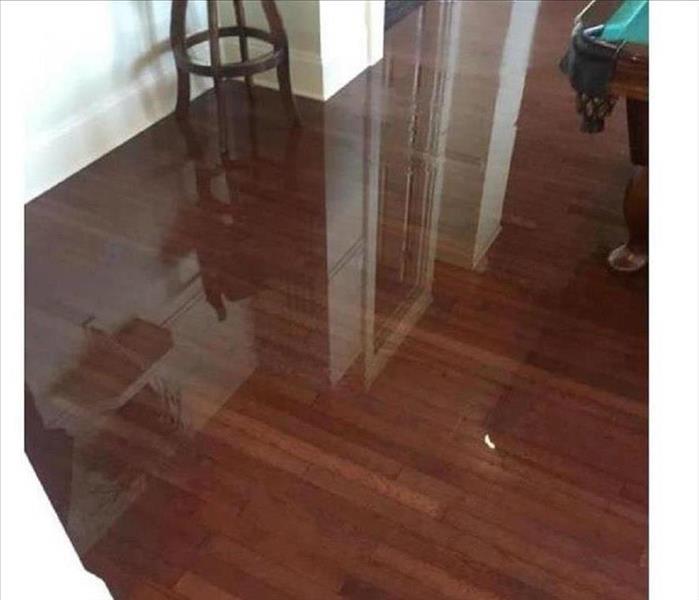 Time is not on your side in a water damage situation.
Time is not on your side in a water damage situation.
As much as you try to prepare, disasters can strike at any time. Should you experience water damage from clean water in your home, here's what you should (and shouldn't do) until help has arrived:
DO:
-Shut off the source of the water if possible or contact a qualified party to stop the water source.
-Turn off circuit breakers for wet areas of the building, when access to the power distribution panel is safe from electric shock.
-Remove as much excess water as possible by mopping and blotting.
-Wipe excess water from wood furniture after removing lamps and tabletop items.
-Remove and prop up wet upholstery cushions for even drying.
-Place aluminum foil or wood blocks between furniture legs and wet carpeting.
-Remove to a safe, dry place any paintings, art objects, computers, documents and other materials that are valuable or sensitive to moisture.
-Use wooden clothespins to keep furniture skirting off of damp floors.
-Hang draperies with coated hangers to avoid contact with wet carpeting or floors.
-Hang furs and leather goods to dry separately at room temperature.
DON'T:
-Enter rooms with standing water where electrical shock hazards may exist.
-Enter affected areas if electrical outlets, switches, circuit breakers or electrical equipment are exposed to water. ALWAYS avoid electrical shock hazards.
-Leave books, newspapers, magazines or other colored items on wet carpets or floors to cause staining.
-Leave Oriental rugs or other colored rugs on wet wall-to-wall carpets to cause staining.
-Use your household vacuum cleaner to remove water, possibly causing electrical shock or damage to the vacuum cleaner.
-Use TV's or other appliances while standing on wet carpets or floors, especially not on wet concrete floors.
-Turn on ceiling fixtures if ceiling is wet or enter rooms where ceilings are sagging from retained water.
Please follow these DO & DON'Ts to help reduce damage and increase the chances of a successful restoration.
These emergency tips will assist you in taking the proper action until the SERVPRO of Western Dutchess County professionals arrive. Keep our number in your phone- (845)831-3600.
Western Dutchess County 24 Hour Emergency Water Damage Service
10/23/2018 (Permalink)
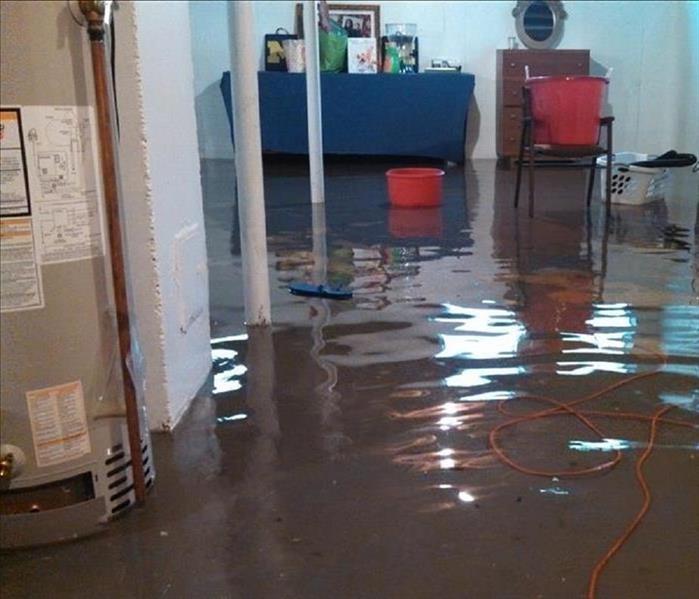 A delay of just a few hours can greatly increase the severity of the water damage.
A delay of just a few hours can greatly increase the severity of the water damage.
SERVPRO of Western Dutchess County is available 24 hours a day for water emergencies, large or small. When you are dealing with water damage, immediate action is crucial. A delay of just a few hours can greatly increase the severity of the water damage.
We Answer the Phone Ready to Help. Call Today (845)831-3600.
We understand that when you call us, you may be feeling confused, stressed, and vulnerable. You need an expert to guide you through this crisis. SERVPRO of Western Dutchess County has the specific water damage training and experience to help you through this tough time. We specialize in water damage restoration—in fact, it's the cornerstone of our business.
What to Expect
When you call, we will ask several questions regarding your water damage emergency. These questions will help us determine what equipment and resources to bring, including how many trained SERVPRO Professionals may be needed.
Our SERVPRO Representative will ask several questions:
- Your name and contact information
- Your insurance information (if applicable)
- The street address of the water-damaged home or business
- When did the flooding or water damage occur?
- What caused the water damage (if known)?
- Is there electricity available (on-site)?
About SERVPRO of Western Dutchess County
SERVPRO of Western Dutchess County specializes in the cleanup and restoration of residential and commercial property after a fire, smoke or water damage event. Our staff is highly trained in property damage restoration. From initial and ongoing training at SERVPRO’s corporate training facility to regular IICRC-industry certification, rest assured our staff is equipped with the knowledge to restore your property, Like it never even happened.
Save our number in your phone, SERVPRO of Western Dutchess County (845)831-3600.
Water Damage 24 Hour Emergency Service Available! | SERVPRO of Western Dutchess County
6/28/2018 (Permalink)
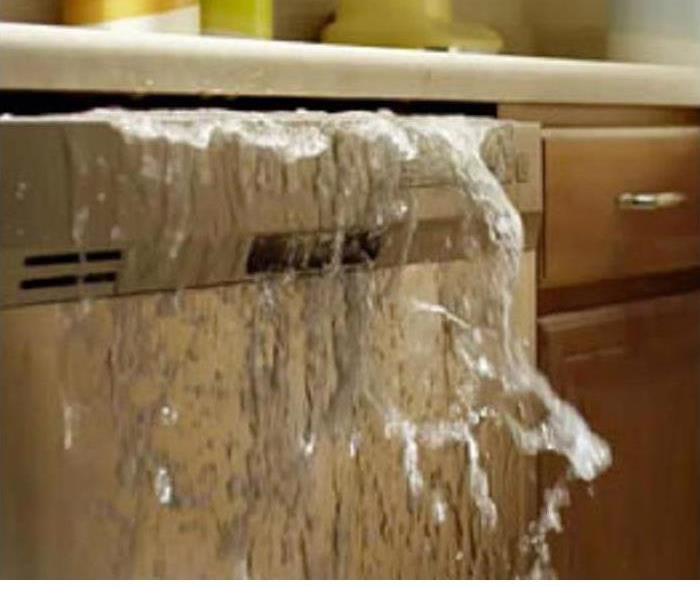 Call 845-831-3600 for help with your water damage!
Call 845-831-3600 for help with your water damage!
SERVPRO of Western Dutchess County is available 24 hours a day for water emergencies, large or small. When you are dealing with water damage, immediate action is crucial. A delay of just a few hours can greatly increase the severity of the water damage.
We Answer the Phone Ready to Help
Call Today - 845-831-3600
We understand that when you call us, you may be feeling confused, stressed, and vulnerable. You need an expert to guide you through this crisis. SERVPRO of Western Dutchess County has the specific water damage training and experience to help you through this tough time. We specialize in water damage restoration—in fact, it's the cornerstone of our business.
What to Expect
When you call, we will ask several questions regarding your water damage emergency. These questions will help us determine what equipment and resources to bring, including how many trained SERVPRO Professionals may be needed.
Our SERVPRO Representative will ask several questions:
- Your name and contact information
- Your insurance information (if applicable)
- The street address of the water-damaged home or business
- When did the flooding or water damage occur?
- What caused the water damage (if known)?
- Is there electricity available (on-site)?
About SERVPRO of Western Dutchess County
SERVPRO of Western Dutchess County specializes in the cleanup and restoration of residential and commercial property after a fire, smoke or water damage event. Our staff is highly trained in property damage restoration. From initial and ongoing training at SERVPRO’s corporate training facility to regular IICRC-industry certification, rest assured our staff is equipped with the knowledge to restore your property.
The Types of Pollution Found After Water Damage | SERVPRO® of Western Dutchess County
6/25/2018 (Permalink)
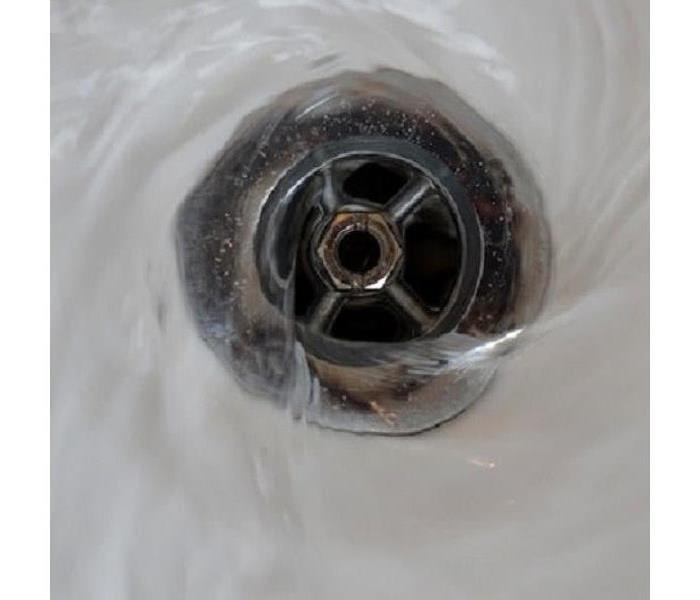 Different Types of Polluted Water need different cleaning guidelines
Different Types of Polluted Water need different cleaning guidelines
When describing water damage, you’ve likely heard terms such as “black water” and “clear water” to describe the danger of the water left behind. While black water is undoubtedly more hazardous than clear water, there are actually three types of pollution found after water damage, and they can all cause their own form of harm to a home or office.
The time after water damage is a chaotic one, which is why we’ve taken the time to outline the three types of water contamination you might come across.
Levels of PollutionCategory 1: “Clear water” is the least contaminated level, as it refers to water originating from a clear source that is free from pollution. Water from leaky faucets, broken inbound pipes, direct rainwater or faulty water supply lines would fall into this category. It is not recommended, but category 1 water should not be considered dangerous if consumed.
Category 2: A step up from clear water is grey water, which is a bit more serious. This is wastewater generated from drain overflows, appliance damages and other types of typical household flooding. This water is either contaminated from the source or has come into contact with many surfaces, so category 2 water is considered dangerous to consume.
Category 3: Category 3 water—black water—is the most notorious, and the most dangerous of the categories. Rising flood waters, sewage overflows or water that has become a breeding ground for bacteria are all causes for concern and can cause illness or death if consumed.
Categories Will ChangeWater damage only becomes more complicated after the initial floodwaters settle, because water that starts in one category can quickly advance to another. Water can develop higher pollution levels from coming into contact with surfaces or sitting stagnant and breeding bacteria and can become even more dangerous as time goes on.
Because this is impossible to determine solely based on appearance, it’s essential to get professional water restoration for peace of mind and a properly restored property.
If you’re dealing with water damage and you’re not sure what to do, SERVPRO® has a team of water restoration professionals that’s here to help!
Ice Damming Tips for Dutchess County!
2/27/2017 (Permalink)
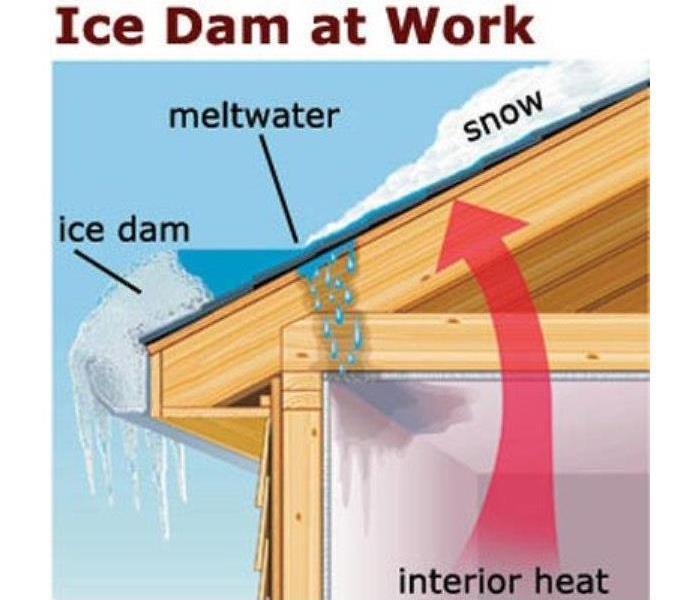 Explanation of how ice damming occurs in your home.
Explanation of how ice damming occurs in your home.
Water Coming into your home in Ulster County? It may be ice damming! SERVPRO can help!
What is ice damming?
What is an ice dam? Ice dams form when heated air melts roof snow downward into water dammed behind still frozen ice. When the water that is trapped cannot flow or run through the gutter system in can back flow under the roofs shingles and into your home's interior areas
When will ice dams occur?
- The right weather conditions for ice damming is usually when outside air temperatures are in the low 20s (F) for several days with several inches of snow on the roof.
- If you have poor attic insulation, your chances of ice damming drastically increases.
How do I prevent ice dams?
- Keep the attic air temperature below freezing when the outside air temperature is in the low 20s. This can reduce the occurrence of ice dams.
- Lay more insulation down on the attic floor to prevent the warm household air to penetrate into the attic.
- Provide good attic ventilation to replace warm air in the attic with cold outside air.
- Keep the bottom four feet of the roof clear of snow. Be careful not to damage the shingles
What NOT to do!
- DO NOT attempt to “chip away” the ice of an ice dam. It will likely lead to shingle damage
- DO NOT install mechanical equipment or water heaters in attics, especially in cold climates.
- DO NOT use salt or calcium chloride to melt snow on a roof. These chemicals are very corrosive and cam shorten the life of metal gutters, downspouts and flashings. Runoff that contains high concentrations of these chemicals can damage nearby grass and plants.
Call SERVPRO of Kingston/New Paltz today if you have any questions or concerns about ice damming! We are available 24/7 at 845-831-3600!
Ice Damming Tips for Dutchess County!
2/27/2017 (Permalink)
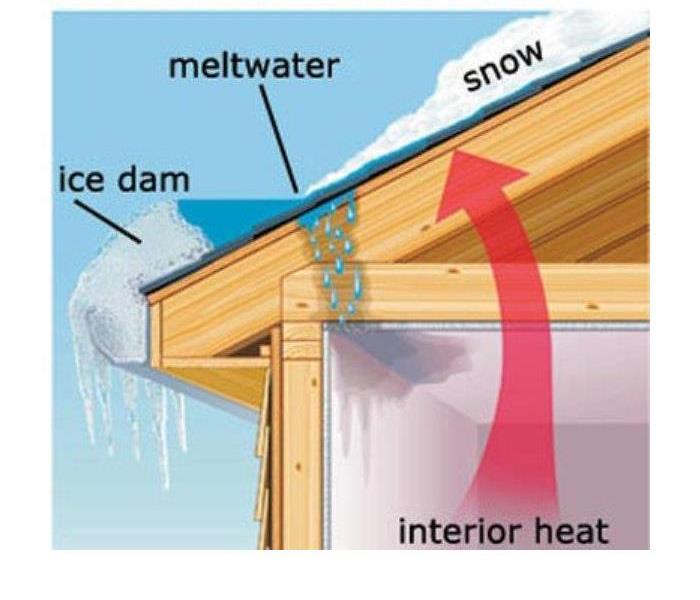 Explanation of how ice damming occurs in your home.
Explanation of how ice damming occurs in your home.
Water Coming into your home in Dutchess County? It may be ice damming! SERVPRO can help!
What is ice damming?
What is an ice dam? Ice dams form when heated air melts roof snow downward into water dammed behind still frozen ice. When the water that is trapped cannot flow or run through the gutter system in can back flow under the roofs shingles and into your home's interior areas
When will ice dams occur?
- The right weather conditions for ice damming is usally when outside air temperatures are in the low 20s (F) for several days with several inches of snow on the roof.
- If you have poor attic insulation, your chances of ice damming drastically increases.
How do I prevent ice dams?
- Keep the attic air temperature below freezing when the outside air temperature is in the low 20s. This can reduce the occurance of ice dams.
- Lay more insulation down on the attic floor to prevent the warm household air to penetrate into the attic.
- Provide good attic ventilation to replace warm air in the attic with cold outside air.
- Keep the bottom four feet of the roof clear of snow. Be careful not to damage the shingles
What NOT to do!
- DO NOT attempt to “chip away” the ice of an ice dam. It will likely lead to shingle damage
- DO NOT install mechanical equipment or water heaters in attics, especially in cold climates.
- DO NOT use salt or calcium chloride to melt snow on a roof. These chemicals are very corrosive and cam shorten the life of metal gutters, downspouts and flashings. Runoff that contains high concentrations of these chemicals can damage nearby grass and plants.
Call our SERVPRO of Western Dutchess County office today if you have any questions or concerns about ice damming! We are available 24/7 at 845-831-3600!
Dutchess & Ulster County Residents: We Specialize in Flooded Basement Cleanup and Restoration!
6/13/2016 (Permalink)
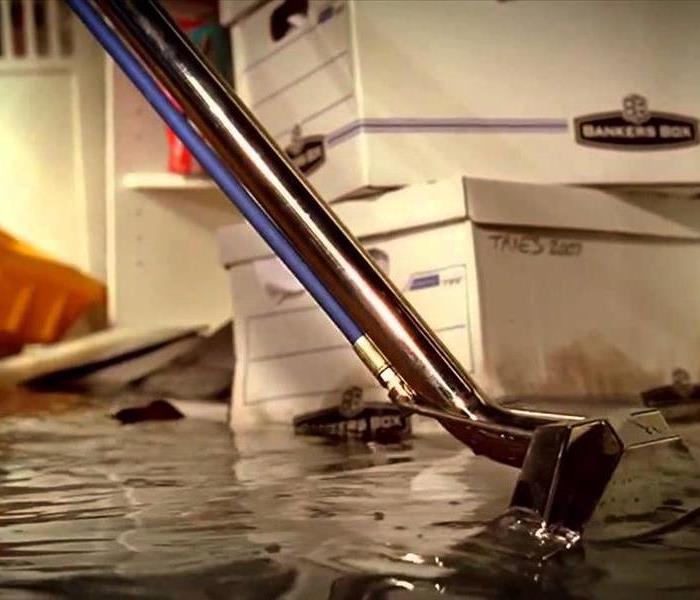 Basements can easily flood from heavy rains in any Dutchess & Ulster County home.
Basements can easily flood from heavy rains in any Dutchess & Ulster County home.
A basement can flood at any time, although flooding most often occurs during heavy rainfall. Basements are inherently prone to flooding because they are the lowest level of a building and are normally built partly or entirely below ground level. There are a number of reasons why your Ulster & Dutchess County basement could flood, including:
- A blocked or failed sewer lateral pipe
- Heavy rain causes surface water to pool around your home
- Storm sewer backup
- Sanitary sewer backup
- Foundation drainage failure
- Water supply-line break or hot-water tank failure
- And many more
Have Questions about Basement Flooding?
Call Today - 845-831-3600
If flood water is not handled quickly and properly, it can jeopardize your health and safety, and cause severe damage to your home’s structure. Remember, the longer you wait, the worse the problem will get.
The bottom line: a flooded basement can jeopardize your health, safety, and your home’s integrity. It’s worth making a call to SERVPRO of Kingston/New Paltz & SERVPRO of Western Dutchess County and let our trained, professional crews handle the situation safely and correctly. We have earned the tust of hundreds of homeowners, business owners, and property professionals.
We are Flooded Basement Specialists:
- We are Available 24 hours/7 days per week
- We’re a Preferred Vendor to many National Insurance Companies
- We Bill The Insurance Directly – One Less Thing For You To Worry About
- Our Technicians are Highly-Trained in Water Restoration Techniques
- We use s500 IICRC Restoration Standards
- Advanced Inspection and Extraction Equipment
Basement Flooded? Call Us Today – We’re Ready To Help
845-255-4334 or 845-831-3600
Faster to your Dutchess & Ulster County Water Damage Event
6/13/2016 (Permalink)
 SERVPRO of Western Dutchess County & SERVPRO of Kingston/New Paltz provides 24 hour fire & water damage service in Dutchess & Ulster County.
SERVPRO of Western Dutchess County & SERVPRO of Kingston/New Paltz provides 24 hour fire & water damage service in Dutchess & Ulster County.
Flooding and water emergencies don’t wait for regular business hours and neither do we. SERVPRO of Western Dutchess County & SERVPRO of Kingston/New Paltz provides emergency cleaning and restoration services 24 hours a day, 7 days a week—including all holidays.
Faster To Any Size Disaster
Flooding and water damage is very invasive. Water quickly spreads throughout your home and gets absorbed into floors, walls, furniture, and more. SERVPRO of Western Dutchess County & SERVPRO of Kingston/Ulster arrives quickly and starts the water extraction process almost immediately. This immediate response helps to minimize the damage and the cleaning and restoration costs.
Need Emergency Service? Call Us 24/7 – 845-831-3600 or at 845-255-4334
Water Damage Timeline
Within Minutes
- Water quickly spreads throughout your property, saturating everything in its path.
- Water is absorbed into walls, floors, upholstery, and belongings.
- Furniture finishes may bleed, causing permanent staining on carpets.
- Photographs, books, and other paper goods start to swell and warp.
Hours 1 - 24:
- Drywall begins to swell and break down.
- Metal surfaces begin to tarnish.
- Furniture begins to swell and crack.
- Dyes and inks from cloth and paper goods spread and stain.
- A musty odor appears.
48 Hours to 1 Week:
- Mold and mildew may grow and spread.
- Doors, windows, and studs swell and warp.
- Metal begins to rust and corrode.
- Furniture warps and shows signs of mold.
- Paint begins to blister.
- Wood flooring swells and warps.
- Serious biohazard contamination is possible.
More Than 1 Week:
- Restoration time and cost increase dramatically; replacing contaminated materials and structural rebuilding may be extensive.
- Structural safety, mold growth, and biohazard contaminants pose serious risks to occupants.
About SERVPRO of Western Dutchess County & SERVPRO of Kingston/New Paltz
SERVPRO of Western Dutchess County & SERVPRO of Kingston/New Paltz specializes in the cleanup and restoration of residential and commercial property after a fire, smoke or water damage event. Our staff is highly trained in property damage restoration. From initial and ongoing training at SERVPRO’s corporate training facility to regular IICRC-industry certification, rest assured our staff is equipped with the knowledge to restore your property.
Dutchess County 24 Hour Emergency Water Damage Service
6/13/2016 (Permalink)
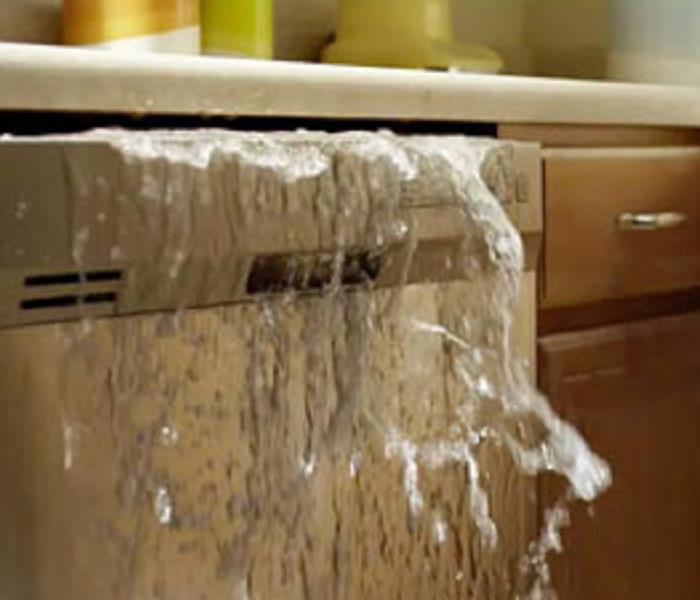 SERVPRO of Western Dutchess County provides 24 hour fire and water damage restoration service in Dutchess County.
SERVPRO of Western Dutchess County provides 24 hour fire and water damage restoration service in Dutchess County.
SERVPRO of Western Dutchess County is available 24 hours a day for water emergencies, large or small. When you are dealing with water damage, immediate action is crucial. A delay of just a few hours can greatly increase the severity of the water damage.
We Answer the Phone Ready to Help
Call Today - 845-831-3600
We understand that when you call us, you may be feeling confused, stressed, and vulnerable. You need an expert to guide you through this crisis. SERVPRO of Western Dutchess County has the specific water damage training and experience to help you through this tough time. We specialize in water damage restoration—in fact, it's the cornerstone of our business.
What to Expect
When you call, we will ask several questions regarding your water damage emergency. These questions will help us determine what equipment and resources to bring, including how many trained SERVPRO Professionals may be needed.
Our SERVPRO Representative will ask several questions:
- Your name and contact information
- Your insurance information (if applicable)
- The street address of the water-damaged home or business
- When did the flooding or water damage occur?
- What caused the water damage (if known)?
- Is there electricity available (on-site)?
About SERVPRO of Western Dutchess County
SERVPRO of Western Dutchess County specializes in the cleanup and restoration of residential and commercial property after a fire, smoke or water damage event. Our staff is highly trained in property damage restoration. From initial and ongoing training at SERVPRO’s corporate training facility to regular IICRC-industry certification, rest assured our staff is equipped with the knowledge to restore your property.
Equipment Spotlight: Desiccant Dehumidifier
1/6/2016 (Permalink)
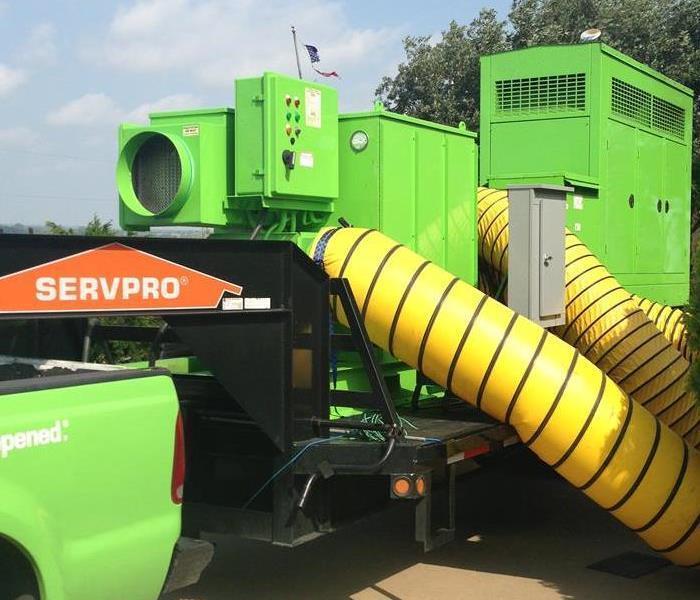 Desiccant Dehumidifier being used on a Large Loss Project.
Desiccant Dehumidifier being used on a Large Loss Project.
A desiccant dehumidifier has a moisture absorbing wheel inside the unit. The wheel is made of silica gel – which is the desiccant (drying) element. Air enters the unit through an opening and travels through the silica gel impregnated wheel. When the air reaches the other side of the wheel it is dry and pushed out of the unit by a high static blower.
Tips for Preventing Broken Pipes
1/1/2016 (Permalink)
 Broken pipes can lead to major water damage in your home or office.
Broken pipes can lead to major water damage in your home or office.
It's getting very cold out there and winter is upon us! Don't be caught with broken pipes and water throughout your home! Here are some tips from the Insurance Information Network of California(2013) to prevent this from occurring:
1. Disconnect all garden hoses and other outside hose connections. If possible, use an indoor valve to shut off and drain water from pipes leading to outside faucets.
2. Insulate all exposed pipes located in your basement, under your home, on outside walls or in attics. For pipes with northern exposures, use heat tape according to the manufacturer's instructions. (Improper usage may cause a fire)
3. Set the thermostat to at least 55 degrees even when your home is vacant or unoccupied during the winter. If you plan to be away during cold-weather months, have someone regularly check your home to make sure it's staying warm enough to prevent freezing.
4. Winterize sprinkler systems according to the manufacturer's recommendations. Blowing out excess water with a compressor may be the best way to prevent frozen and broken pipes. If you have a swamp cooler, winterize it by disconnecting the water source and clearing the line.
5. Very important tip is knowing how to shut off the water supply if a pipe bursts. Quick action can minimize damage significantly!
SERVPRO® has Water Shutoff Tags that we can supply people to help prepare them in case of a broken pipe!
Contact us today at 845-831-3600 if you’d like a complimentary tag!
Flooding Tips
4/11/2014 (Permalink)
You know what they say...April Showers, Bring May Flowers. Well it is time of year...rain and more rain! And with all this rain...the potential for flooding increases! In the event of water damaged caused by flooding our team is well equipped and well trained to make it "Like it Never Even Happened". Here are a few tips to help get the situation under control until we get there:
1. Remove as much excess water as possible by mopping and blotting.
2.Remove and prop up wet upholstery cushions to help even out the drying process.
3. Try and wipe up the excess water from any wood furniture after removing all tabletop items
4. Do not leaves books, newspapers, magazines or other colored items on any flooring to avoid possible staining.
What is an Ice Dam?
2/25/2014 (Permalink)
Ice dams form when heated air melts roof snow downward into water dammed behind still frozen ice. When the water that is trapped cannot flow or run through the gutter system in can backflow under the roofs shingles and into your home's inteior areas.
Helpful Preventative Tips: Pipe Breaks
1/14/2014 (Permalink)
Pipe Breaks are one of the most common water damages that we receive from December to March at SERVPRO. When water freezes it expands. Therefore, if water freezes in a pipe, the pipe can expand enough to the point that it bursts. However, it’s not necessarily the frozen water that caused the direct burst. It is the water pressure between the ice and the closed faucet. That pressure is enough to break a pipe and cause a water damage in your home or office.
Helpful Preventative Tips:
· Keep cabinet doors open during cold spells. This allows warm air to circulate around pipes.
· Keep a slow trickle of water flowing through faucets, especially if the pipes run through unheated or uninsulated areas of your home and business.
· Keep your home at a temperature no lower than 55°F (12°C).
· When going away, ask a friend or neighbor to check your house daily to make sure it’s warm enough to prevent freezing.
· Seal leaks that allow cold air inside where pipes are located. Use caulk or insulation to keep the heat in.
· Insulate pipes in crawl spaces and the attic. These exposed pipes are most susceptible to freezing.
Tip of the Week!
11/6/2013 (Permalink)
 Broken Pipes
Broken Pipes
It's getting very cold out there and winter is upon us! Don't be caught with broken pipes and water throughout your home! Here are some tips from the Insurance Information Network of California (2013) to prevent this from occurring:
1. Disconnect all garden hoses and other outside hose connections. If possible, use an indoor valve to shut off and drain water from pipes leading to outside faucets.
2. Insulate all exposed pipes located in your basement, under your home, on outside walls or in attics. For pipes with northern exposures, use heat tape according to the manufacturer's instructions. (Improper usage may cause a fire.)
3. Set the thermostat to at least 55 degrees even when your home is vacant or unoccupied during the winter. If you plan to be away during cold-weather months, have someone regularly check your home to make sure it's staying warm enough to prevent freezing.
4. Winterize sprinkler systems according to the manufacturer's recommendations. Blowing out excess water with a compressor may be the best way to prevent frozen and broken pipes. If you have a swamp cooler, winterize it by disconnecting the water source and clearing the line.
5. Very important tip is knowing how to shut off the water supply if a pipe bursts. Quick action can minimize damage significantly!
 A pipe in the upstairs bathroom broke sending gallons of water through the ceiling into the floor below.
A pipe in the upstairs bathroom broke sending gallons of water through the ceiling into the floor below.





 24/7 Emergency Service
24/7 Emergency Service




























































